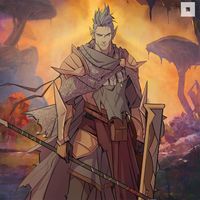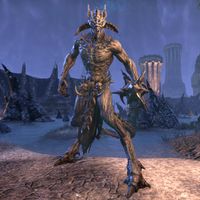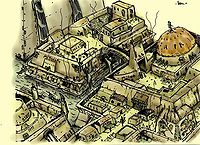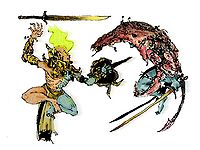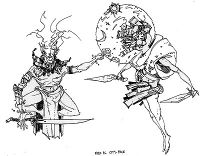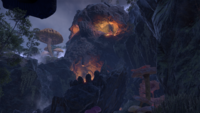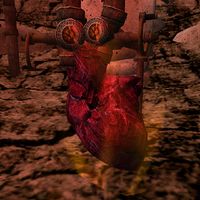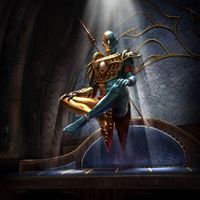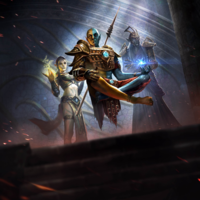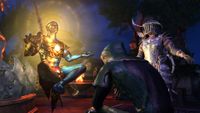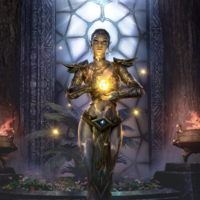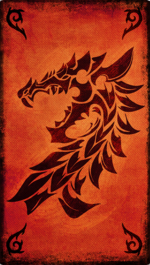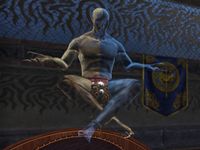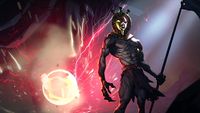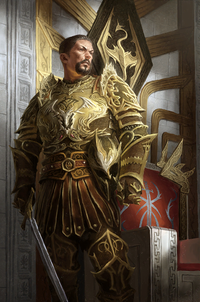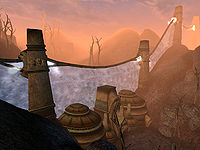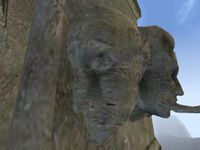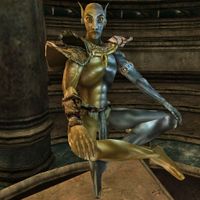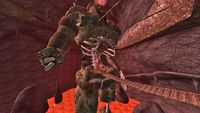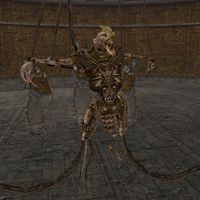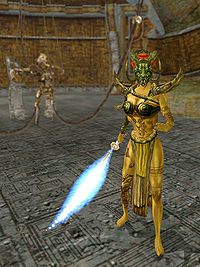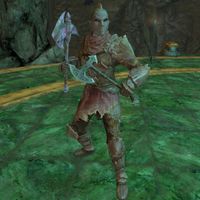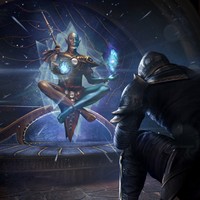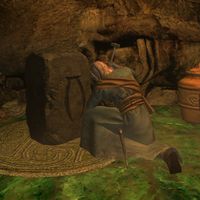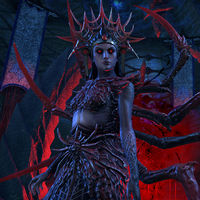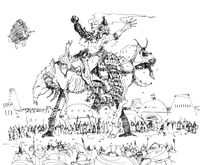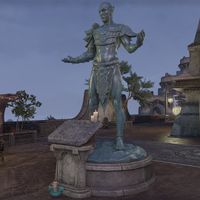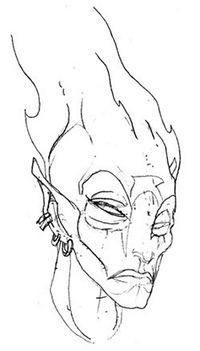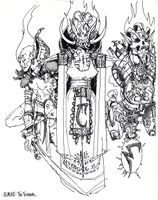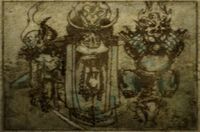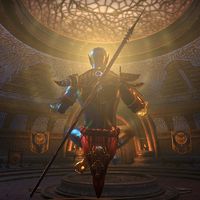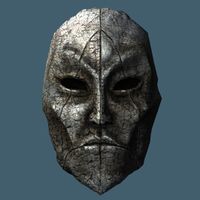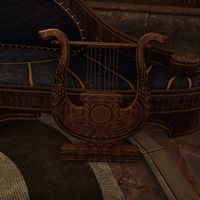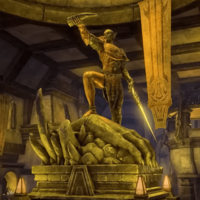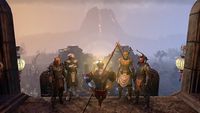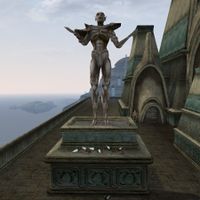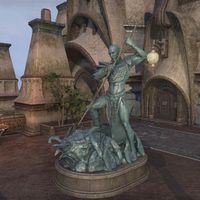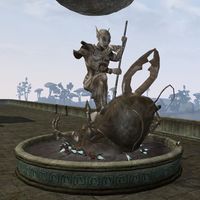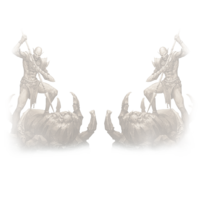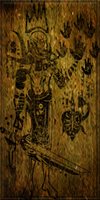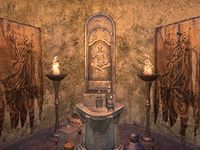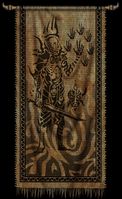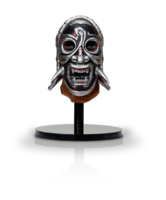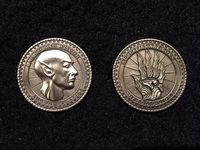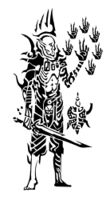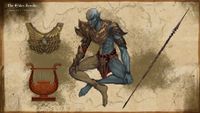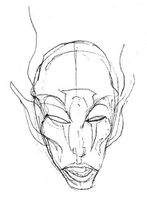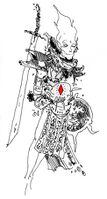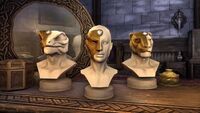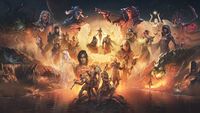Lore:Vivec
This article is about the god. For the city, see Vivec City.
—Lord Vivec
| Lord Vivec | |||
|---|---|---|---|
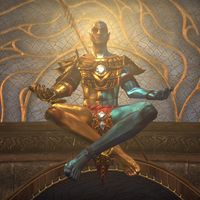 Lord Vivec in his temple circa 2E 582 Lord Vivec in his temple circa 2E 582
|
|||
| Race | Chimer & Dunmer | Gender | Male (predominantly) and Female |
| Resided in | Mourning Hold Balmora Vivec City |
||
| Appears in | Morrowind, ESO, Legends | ||
Contents
- 1 History
- 1.1 Origins
- 1.2 War with the Northern Men
- 1.3 Pomegranate Banquet
- 1.4 Reach Heaven by Violence
- 1.5 Monster Children
- 1.6 War of the First Council
- 1.7 Achieving Divinity and Azura's Curse
- 1.8 Living Gods of Morrowind
- 1.9 Four-Score War
- 1.10 Second Akaviri Invasion
- 1.11 Three Banners War
- 1.12 Days of Fire
- 1.13 The Red Jewel of Conquest
- 1.14 Keeper of the Holy Land
- 1.15 The Nerevarine Prophecy
- 1.16 Fate and Legacy
- 2 Divinity
- 3 Teachings
- 4 Personal Life
- 5 Artifacts
- 6 Bibliography
- 7 Gallery
- 8 Notes
- 9 See Also
- 10 References
Vivec (also spelled Vivek),[1] or Vehk, Warrior-Poet deity of the Dunmer and Vi in the AlmSiVi, was the Guardian God-King of the holy land of Vvardenfell, and ever-vigilant protector from the dark gods of the Red Mountain, the gate to hell.[2] He is also called the Master of Morrowind.[3] Though some aspects of his past are blurred by time and questions surround some of his more controversial choices, Vivec has always represented the spirit and duality of the Dunmer people, which is reflected in his half-Dunmer, half-Chimer appearance.
The Warrior-Poet spent his long life creating numerous works and wonders. He was a prolific writer, perhaps most notably with the 36 Lessons, a series of cryptic texts widely open to an incredible amount of speculation and conjecture, primarily to act as a guide for the prophesized Nerevarine. Numerous artifacts were associated with the God-King, including his legendary spear Muatra. For hundreds if not thousands of years, he mostly resided at the pinnacle of his Palace in the city to which he lent his own name, Vivec. Hundreds of pilgrims and tourists visited his holy city daily.[4][5]
He guided and protected the Dunmer until his loss of divinity and subsequent disappearance near the end of the Third Era, a sacrifice he not only accepted, but helped to bring about.[6] The Tribunal Temple would collapse in his absence. The New Temple refers to him as Saint Vivec and declared him a member of the False Tribunal.[7]
Vivec's reign for thousands of years over Morrowind earned him many titles. His nature as an artist and a masterful combatant earned him the appellation Warrior-Poet.[8] Other honorifics related to his nature as a poet were variously Poet,[9] God-Poet,[9] and Child of Verse and Metaphor.[8] Vivec's sigil was that of the sword and thus he had titles such as Blade[8] and Sword of the Triune.[10][11] Another symbol of Vivec was the harp as he often expressed himself through song and music so held the occasional descriptor Lyre.[8] Some of his titles referenced his emphasized dualistic nature, among these were Magic Hermaphrodite,[10] Martial Axiom,[10] and Child of Truth and Falsehood.[8] Other titles attributed to Vivec in reverence are numerously Lord,[12] Our Lord,[12] Master of Morrowind,[13] Lord of the Middle Air,[14] Champion,[15] Guardian God-King,[2] Mastery,[9] and Living God.[12] As Sotha Sil is known as the Father, and Ayem the Mother, Vivec is known as the Son.[16] Mother-Father of Monsters is a title that refers to both his dualistic gender and his monster offspring produced from the union with Molag Bal.[17] His nature as a god of mortal origins has had some refer to him as the Man-God.[18][19] Outsiders had less positive appellations for the deity such as Circle Talker, Ansu-Gurleht, the God of Makes Us Woman, Seed-Bringer,[UOL 1] the Devil,[20] and the Liar.[21]
History[edit]
—Sotha Sil
Origins[edit]
| He Was Not Born a God | Egg-Image |
|---|---|
| Certain accounts speak to a much more mundane origins and rise of Vivec
Vivec was said to have been born in Resdaynia to a mother named Berahzic and a father named Irdri.[UOL 2] His father Irdri was a netchiman by trade and took Vivec under his wing in the trade. Vivec remembered the laughing of the netchimen of his home village when the hunts were good. He marched with his father in the ash, growing strong in the hooks and sail, able to run a junk through silt. At eleven, he sung to an ashkhan.[22] Vivec eventually came to live on his own in the capital city of Resdayn, Mournhold. In Mournhold living on the streets as a gutter-get Vivec had a chance encounter with the Hortator of the Chimer, Indoril Nerevar. Vivec proclaimed that he would shave his head and wield his netch longhook as his weapon of choice in the guard of Nerevar.[UOL 3] At some point, in an act of malevolence, the Daedric Prince Mehrunes Dagon destroyed Ald Sotha, ancestral home of the minor House Sotha, killing all inhabitants save one, a youthful Sotha Sil. Vivec rescued Sotha Sil from the wrath of the Prince of Destruction making him the sole survivor of his now lost House.[23][24] Vivec thereafter raised the young Sil.[24] Vivec and Sotha Sil would both take station in the service of the Chimer Hortator Nerevar as his generals and councilors with Almalexia being his queen.[25][26] Before Vivec's apotheosis when he still labored under the limitations of mortality, he had a confrontation with a Lurker servant of Hermaeus Mora by the name of Vro-Kuul-Sha the Deepreaver. It was said to be a brutal bout with the Lurker nearly defeating Vivec but in the end, even a mortal Vivec proved unbeatable.[27] 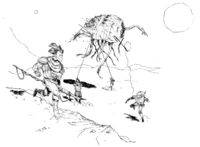 Netchiman hunting netches |
An account that is riddled in much more metaphor and mystique is found in the 36 Lessons of Vivec
Vivec's mother the netchiman's wife was approached by Ayem and informed an image of Vivec resided within her before being tossed in the sea by Ayem to the Dreugh who changed her sex so she could give birth to the image as an egg.[28] She was then approached by Seht who proclaimed that the netchiman's wife held an egg of his brother-sister which she was to nurture until the arrival of the Hortator before lifting her back to the surface to land.[28] Vivec as an egg-image was approached by eight Daedra, the Barons of Move Like This and their leader, the Demiprince Fa-Nuit-Hen.[28] Fa-Nuit-Hen and the Barons taught Vivec new motions and terrible fighting styles, and ultimately the great secret of the Unmixed Conflict Path which Vivec was able to fully understand after prolonged hallucination upon Premeditated Modesty.[28][29] The Demiprince believed this encounter left an impression on the youthful Vivec.[30] Fa-Nuit-Hen also informed Vivec's mother where to go to find the Hortator, to the lands of the Indoril.[28] Along the journey of looking for the lands of Indoril, the netchiman's wife and the egg of Vivec were approached by several spirits, the last of these spirits was the Daedric Prince Mephala. Vivec realized that he was born before as Mephala and could see what he was in the ancient times, the egg-image joined with the Daedric Prince and took its secrets.[31] Vivec's mother wandered upon a Dwemeri cave who were at this time enemies of the Chimer, they killed Vivec's mother to study the egg of Vivec but Vivec vexed them with a rumination on love and so the Dwemer placed the egg in a Simulacrum clone of the netchiman's wife and sent them on their way.[32] Vivec and the Simulacrum were approached by more spirits including Lobbyists for the Coincidence Guild, and an Old Bone of the earth. Vivec fused the essence of the Old Bone with his own and became a ruling king of the world.[33] The Simulacrum of Vivec's mother that the Dwemer built had failed and fallen, the construct and the egg were later discovered by a merchant caravan that was bound for the capital city Almalexia.[34] Nerevar was among this caravan and Vivec placed a message in his head that was both metaphorical and cryptic but ultimately inspired Nerevar to slay the caravan captain and take the caravan for his own.[34][16] The caravan proceeded to the capital city Almalexia with rumblings taking place in Oblivion over these events.[35] Nerevar and the egg of Vivec then finally arrived to the capital city and were greeted by Ayem and Seht, Vivec at last emerged from the egg and Vehk, Ayem, and Seht were finally as one Almsivi with Nerevar becoming the Hortator.[36] |
War with the Northern Men[edit]
After these things were done a tentative alliance was made between the Chimer, ruled by the Hortator Nerevar and his councilors Almsivi, and the Dwemer, led by King Dumac and his High Priest Kagrenac. The alliance was made in order to go to war with the common enemy the Nords, whose Empire had taken control of the whole of Resdayn.
As the battles between the armies of the two sides took place, Vivec and Nerevar took to facing the most powerful chieftains of the Nords in personal combat, all of whom possessed the great and terrible powers of the thu'um.[37] One of these chieftains known as Chemua, the Running Hunger, who appeared as a mounted soldier with a fully enclosed helm had the ability to give clouds stomach aches and turn the rain over Resdayn into bile. Chemua destroyed several Chimeri villages and ate the Chimer hero Dres Khizumet-e, and sent the shade of this hero back towards Nerevar as an assassin. Ultimately, the Hortator and Vivec slayed Chemua.[37] Another of the chieftains known as Bhag, the Two-Tongued had the powers of Surety and Form Change. Vivec being the Poet, alone among the Chimer and Dwemer could understand the thu'um of the Nords and thus was able to slay Bhag in a great debate while employing invisibility to give him the edge.[37] Barfok, Maid of Planes, who appeared as a winged human had the ability to always win every battle she took place in as she could shape outcomes with her singing. Vivec stuffed her mouth with his "milk finger" to prevent her from singing Resdayn into ruin and thus was able to defeat her.[37]
Of the more powerful of the Nordic chieftains was Hoaga, the Mouth of Mud, most commonly known to history as Hoag Merkiller. Hoag could eat the soil of the earth and when his men fell, he would breathe it back into their bodies reviving them and allowing them to continue fighting, albeit slower. Hoaga destroyed many Chimeri villages and Dwemeri strongholds before finally being defeated and driven off.[37] Lastly came the confrontation with the most powerful of the Nordic chieftains, Ysmir Wulfharth. Ysmir was dark, grim, and the most silent of the chieftains but when he spoke villages were uplifted and thrown into the sea. Wulfharth was ultimately driven back when he faced off against the Chimer Hortator Nerevar, who grabbed his shouts by hand until his power throat bled. The shouts were subsequently given to Vivec, who bound them into an ebony listening frame. This listening frame was placed on Wulfharth's head, which drove him mad and turned him away.[37] This planted the seed for the passionate, undying hatred that Wulfharth would come to have for Almsivi.[38]
With the Nordic chieftains defeated and their armies routed, the Nordic Empire was repelled from Morrowind at the hands of the Chimer-Dwemer alliance. This triumph led to the formation of the First Council.[25][26] Almalexia and Nerevar thereafter officially wed and Dwarf-King Dumac presented them with the marvelously crafted twin blades Hopesfire and Trueflame as a gift.[39] Nerevar and Dumac had become blood friends and Resdayn knew unprecedented peace.[39] Vivec was considered both the most gallant knight, and most subtle rogue of the First Council.[40]
Pomegranate Banquet[edit]
Twice as much, I am sure, as the oceans have to share
Hell, my sweet, is a fiction written by those who tell the truth
My mouth is skilled at lying and its alibi a tooth"
—Vivec's poem to Molag Bal
After the war with the Nords, Vivec ventured out to the Ashlands and found a stretch of badlands in the Molag Amur region to practice his giant-form. The Warrior-Poet was approached by the Daedric Prince Molag Bal of the House of Troubles who made his presence and intentions known.[41] Vivec let the Daedra Lord know that if they were to marry he would prefer a ceremony of sorts. The King of Rape responded with Pomegranates springing from the badlands and a group of Chimer mystics came and read off scriptures for the occasion.[41] Vivec informed Molag that the whole of him could not stay the whole time and that he could have his head for only an hour as he still had more wisdom to impart of the Hortator Nerevar. Before his head departed, the Warrior-Poet spoke two poems to the Lord of Domination, and Molag Bal in turn gave a new word of power to Vivec, CHIM, the secret syllable of royalty.[41] This marriage produced a race of supermonster children. The sons and daughters of Molag Bal and Vivec numbered in the thousands.[41][42][43][44][13]
Vivec's head found itself to the Hortator for a council. Vivec spoke of the essential steps the Hortator, the Ruling King of the earth would have to undergo. Vivec spoke of the Sharmat, and the heart that he guards at the center that cannot hold. Vivec claimed that his removal would refill the heart and therefor he was the enigma that must be removed among Almsivi. Vivec warned he would murder the ruling king time and again until he understood this.[45]
After eighty eight days of his body laying with Molag Bal, during which time Molag filled Vivec's feet with Daedra blood, Vivec's head had returned to assess the situation.[46] The union had taken place upon the Daedric Ruin of Bal Ur, the supposed birth place of Molag Bal where the Doom Drum Lorkhan had tricked Molag Bal into becoming mortal.[47] Vivec noticed his body was tenderly used and pointed this out to which Molag Bal responded his love was accidentally shaped like a spear. Vivec bit new words onto Molag's spear so it could wrought more than ruin.[46] Disaster was struck when the Chimer, Demons, and Monsters who bore witness to this took out their spears and imitated this biting which caused the earth to crack and spawned a new race that was born of the biters that were terrible and caused destruction. Vivec however had learned a new secret from Molag Bal when he had bitten him and thus was able to change his own spear into a more terrible thing.[46]
Vivec named his new spear Muatra meaning Milk Taker, Muatra had the ability to turn anyone Vivec touched with it barren and withered into bones.[46] Vivec on the sight of Bal Ur attacked the King of Rape Molag Bal and sent him tumbling into the crack of the biters, banishing him back into Oblivion.[46][47] Vivec then wielded Muatra with fury and hunted down and destroyed the biters and their progeny and the event was concluded.[46]
Legends circulated that the Daedric Prince of Knowledge, Hermaeus Mora spied on Vivec and Bal during the Pomegranate Banquet which angered the two. In retaliation, an army of Dreugh was sent after Mora's shrine of worship located in Vvardenfell. The shrine was destroyed and dragged beneath the sea and no more shrines to Mora were allowed to be built in Vvardenfell.[48]
Reach Heaven by Violence[edit]
After the Pomegranate Banquet, Vivec provided further council to the Hortator. Vivec gave further rumination on the Sharmat, and how the ruling king alone, who comes again and again can unmake him.[49] Nerevar did not wish to become slipshod in his lessons and so Vivec implored him to reach Heaven by violence.[50] Nerevar chose an axe from the Fight Racks and named it before departing to the lunar realm of the moons. Nerevar encountered the Parliament of Craters who resented the Hortator's presence, Nerevar slew many of the Craters, and one of the surviving Craters claimed Nerevar fell below the weight of destiny.[50] Nerevar attempted to further subdue the heavens with the named axe but was forced out of the Library of the Sun by the power of Magnus.[51]
Vivec found Nerevar in a grub field on the outskirts of the Deshaan Plain. Vivec and Nerevar walked in silence for a time until eventually they were walking across the Eastern Sea into Akavir.[51] Nerevar and Vivec learned the idiom stroke from the pillow book of the Tsaesci king. Throughout the stay, the Tsaesci serpents vowed on multiple occasions they would have revenge on Tamriel.[51] They ventured north, to the Elder Wood, but found only frozen bearded kings.[51]
The duo ventured west to Yokuda where for a year they studied under their sword-saints. Vivec then later chose a Yokudan king for a wife and produced another race of monsters that were ultimately responsible for destroying the entire west.[51] Vivec avoided going to the south, and instead led Nerevar back to Red Mountain to show him where the Sharmat awaited.[51] Vivec and Nerevar knew it was not the time for that confrontation yet and so instead dueled each other. Vivec marked Nerevar for all of the Velothi to see and then used a spell to seal the wound.[51]
Monster Children[edit]
Now that Vivec believed he had counseled Nerevar as much as he could, he informed Almalexia that he was setting off to destroy eight of his progenies from the Pomegranate Banquet with Molag Bal that had escaped his wrath.[10] Vivec stepped into a non spacial-space that filled to capacity with mortal interaction and information. He saw the twin head of a ruling king who wore a crown that looked like shackles with eight imperfections rubbed into precious stones.[52]
Vivec built a structure known as the Provisional House at the center of this Secret Door so he could see the ages to come and launch his attack on his monster children.[52]
Moon Axle
Moon Axle was one of the eight monster children from the unholy union of Molag Bal and Vivec, who initially escaped being slain.[41][10] Moon Axle was made of many straight lines, though none would last too long. While Moon Axle was not the mightiest of Vivec's children, he was the most worrisome according to Vivec.[53] He was immune to spears, so Vivec had to use the sword not held instead of Muatra. Vivec wounded Moon Axle heavily with the sword, and in order to finish the monster, switched to his giant form and reached into the west to pull out a canyon.[53] Vivec held the canyon like a horn, reached east to grab a handful of Nix-Hounds, and then blew the souls of the Nix-Hounds through the canyon, making a terrible noise that weakened Moon Axle to the point where Vivec could finally kill it with Muatra.[53]
Treasure Wood Sword
The Treasure Wood Sword was one of the eight monster children from the unholy union of Molag Bal and Vivec, who initially escaped being slain.[41][10] The Treasure Wood Sword found itself in the possession of the Clan Ra'athim of the Chimer House Mora.[54] Vivec demanded that the house return the Treasure Wood Sword to him lest they face his wrath, to which a Bonewalker of House Mora stated they would not return the sword, in part due to a bargain with the Daedric Prince Mephala.[54] Vivec, unpleased with this, employed the services of the Morag Tong. They proceeded to, per the Sermons, destroy the House and Clan in its entirety.[54] The King of Assassins of the Morag Tong reported the assassination of the Prince of House Mora himself to Vivec and presented the Warrior-Poet with the Treasure Wood Sword.[54]
Horde Mountain
Horde Mountain was one of the eight monster children from the unholy union of Molag Bal and Vivec, who initially escaped being slain.[41][10] Three former minor Chimer Houses helped subdue Horde Mountain for Vivec. The Warrior-Poet was overjoyed by this and consolidated these three houses into a new order, his personal guard, the Buoyant Armigers.[55] Vivec then pierced Horde Mountain with Muatra, killing it. The Living God then dispersed the bones to form a new city for him and his Armigers, Vivec City, City of Swords.[55] Almalexia blessed the city with her Ordinators to serve as its honor guard, and Sotha Sil blessed the holy city with a protective spell.[55]
Pocket Cabal
The Pocket Cabal was one of the eight monster children from the unholy union of Molag Bal and Vivec, who initially escaped being slain.[41][10][56] It is said to have hidden itself in the spell-lists of the great Chimeri wizards of the extreme east, which later became the House Telvanni. Vivec ventured to slay the monster, but the tenuous sense-fabric he wore drew out a giant bug. Inside the insect was the most powerful eastern wizard, who scolded Vivec for creating the monster. In retaliation, Vivec stabbed the wizard through his soul. The monster was eventually destroyed by Vivec, who contained it in a dome-head demon. Sotha Sil was fascinated by the creature and asked Vivec if he may treasure it. Vivec gifted them it but warned Seht never to release it into the middle world.[56]
Ruddy Man
The Ruddy Man was one of the eight monster children from the unholy union of Molag Bal and Vivec, who initially escaped being slain.[41][10] They are said to have battled Vivec twice according to the teachings of the Tribunal Temple. He is a carapace who gives power to those who wear him,[57] although he is sometimes considered a dreugh, or an aspect of Molag Bal worshipped by the dreughs.[58] The Ruddy Man endures as a symbol of fear in Dunmer culture.[59]
According to the Temple, the Ruddy Man was created when a Velothi child from Gnisis found a dead carapace, supposedly Molag Bal's old image from long ago when he ruled Mundus as chief of the dreugh-kings. Wanting to scare his village, the child wore the carapace, and the Ruddy Man was formed. Vivec did battle with the monster at the Koal Cave site near Gnisis, creating the West Gash region of Vvardenfell; it is said that the sounds of battle still echo in the region. Vivec was victorious, and went to give the carapace to the dreughs who had once modified his mother. However their leader, the Queen of Dreughs (whose name is not easy to spell), was in a period of self-incubation. Her wardens took the carapace from Vivec in her stead and promised to safeguard it, but this is the first recorded account of the dreughs being liars. Instead, the dreugh imbued the living armor with mythic inflexibility. The Ruddy Man appeared again ten years later at Tear, this time worn by a wayward shaman of the House of Troubles. After defeating him a second time, Vivec gave the carapace to the devout and loyal mystics of the Number Room, who made it into "a philosopher's armor".[57]
The Shrine of Valor was set up in the Koal Cave by the Temple and served as part of the Pilgrimage of the Seven Graces. Pilgrims were told that the Ruddy Man was the father of all dreughs, and that Vivec spared his life if he and his children agreed to give up their tough hides as armor for the Dunmer.[60]
Circa 2E 582, a dreugh known as the Ruddy Broodmother began terrorizing the roads around Molag Mar, killing pilgrim and Buoyant Armiger alike. The Ruddy Broodmother made its lair within the Dreudurai Glass Mine, which the Erabenimsun knew as ancient dreugh spawning grounds.[61] The Vestige, with the help of a group of Ashlanders, drew it out of hiding and slew it. A pilgrim who survived the incident and fled into an ancestral tomb believed the creature to be the mythical Ruddy Man, though Ashlanders denied its existence, claiming that the Broodmother was simply a powerful and cunning dreugh. The Buoyant Armigers considered the thought of the beast being the Ruddy Man borderline heresy. The captain of the Buoyant Armigers at the time suggested that if the Ruddy Broodmother truly was related to the creature of legend, that it might be a lesser creature "cut from the same cloth" as the Ruddy Man.[62]
City-Face
City-Face, originally known as Ha-Note, was one of the eight monster children born from the unholy union of Molag Bal and Vivec, who initially escaped being slain.[41][10] The Grabbers, the mysterious beings of the Adjacent Place who had never built a city of their own, grew jealous of Vivec's marvelous city, and therefore transformed Ha-Note into the being known as City-Face.[63] Vivec, in an act of subterfuge, corrected the error in the monstrous city of the Grabbers, but then stabbed City-Face with the Ethos Knife, killing him.[63][64] The act of Vivec killing City-Face with the Ethos Knife inspired the creation of the Buoyant Armigers' daggers.[64] City-Face was described as similar to the Numidium of the Dwemer.[63]
Lie Rock
Lie Rock was born of Vivec's second aperture,[14] that is to say, Lie Rock was essentially dung excreted from Vivec.[UOL 4] Lie Rock was removed from the Pomegranate Banquet from a forgotten guild known as the Sweeps.[14] Lie Rock escaped the clutches of the Sweeps and ascended to the heavens claiming his divine parentage made him invited into the Hidden Heaven. This Hidden Heaven realm was known as the Scaled Blanket, and housed the Void Ghost.[14] Vivec sent Nerevar to the heavens with the named axe to shave Lie Rock asunder but the Hortator only encountered the Void Ghost, and the two masters engaged in conversation.[14] Lie Rock used this distraction to launch an attack on the city-god Vivec. The inhabitants of Vivec City screamed in terror as they saw the shooting star hurling towards the city out of the sky, but Vivec merely raised his hand and froze Muatra right above the city and pierced it with Muatra killing it.[14]
Nerevar returned from the heavens and saw the frozen comet looming above the city and asked Vivec if it should be removed, to which Vivec responded 'I would have done so myself if I wanted, silly Hortator. I shall keep it there with its last intention intact, so that if the love of the people of this city for me ever disappear, so shall the power that holds back their destruction.' Nerevar said "Love is under your will only" which pleased Vivec, and he informed Nerevar that he had become a Minister of Truth.[14]
Various other tales for the celestial rock exists such as it being flung from the heavens by the Mad God Sheogorath who was bored and wished to destroy Vivec City as the Daedric Prince felt the city was built in mockery of the heavens. Citizens of Tamriel prayed unanswered prayers to the Divines and Daedric Princes alike to stop the rocks fall but only the prayers to the blessed Living Gods were heard. Vivec raised his hand and stopped the descent of the moonlet. Baar Dau itself pledged eternal servitude to the Tribunal thereafter and guarded over the palace of Vivec and served as a citadel for the Ordinators.[60][65]
Another account claimed it was a Magna Ge named Una. Una became separated from her kin as they fled to Aetherius and so Una instead chose companionship with Nirn and thus chose to nestle in close in Vvardenfell right above Vivec City where neither Una nor Nirn would feel alone again.[66]
One Orcish tale claims Baar Dau is not the dung of Vivec as the sermons claim, but rather the dung of Malacath who defecated on the city of the Living God for the disrespect to Malacath's beloved Ogre children, as Vivec had said something about the Goblin-ken that angered Malacath and also done battle with the Flute-and-Pipe Ogres of the West Gash.[66][11]
Yet another scholarly account claimed that Baar Dau was not a rock, but rather an egg. Specifically the chrysalis from which would one day hatch the final monster of Vivec and Molag Bal's ill-fated union that Vivec would engage in glorious battle with.[66]
Gulga Mor Jil
Gulga Mor Jil (stylized GULGA MOR JIL HYAET AE HOOM,[41] meaning "GULGA MOR JIL of the High and the Low")[UOL 5] was one of the eight and most powerful of the monster children from the unholy union of Molag Bal and Vivec, who initially escaped being slain.[41][10] He was said to be the mightiest, and his name is a string of power.[67][41] Unlike the other children, Gulga Mor Jil showed no violent nature or intent to harm others, and accepted his death peacefully. His bones went on to lay the foundations of Necrom, and the runes on his tusks were transcribed onto the Fulcrum Obscura.[67][68] Following their birth, Vivec would go on to neutralize his monster children, and after freezing his seventh child Lie Rock above his palace, he went to the Provisional House and looked into the middle world to find the eighth and final monster, Gulga Mor Jil. In the Provisional House, Nerevar saw a vision of Talos that Vivec told him about earlier; Nerevar asked Vivec why he was always so evasive, to which Vivec said "that to be otherwise was to betray his nature".[67]
Together, Nerevar and Vivec went to a village near where Vivec had first been found by Ayem and Seht as an egg, where Gulga Mor Jil was located. Unlike the other children, he did not act much like a monster, sitting with his legs in the ocean and with a troubled look on his face. When he saw Vivec, he asked why he should have to die and return to oblivion. Vivec told Gulga "that to be otherwise was to betray his nature". This did not seem to satisfy the monster, so Vivec, channeling the mercy that Almalexia possessed, spoke a poem about how the all-consuming fire would make a secret door to the void of Padhome, where those who die would be safe and looked after in the house of Boethiah. This was the same poem Vivec had read to comfort his mother Berahzic.[67][32]
With a peaceful look on his face, Gulga Mor Jil accepted his fate, and after being killed by Muatra his bones became the foundation for the City of the Dead, Necrom.[67] Nerevar then asked Vivec why he asked him to come if he knew the eighth monster would give in so easily. Vivec looked at the him for a long time, and Nerevar understood, concluding "Do not betray your nature. Answer as you will." Vivec said he brought Nerevar because he knew the mightiest of his issue would succumb to Muatra without argument if given consolation beforehand. They looked at each other again for a long time and Nerevar now understood, telling Vivec he was now the "mightiest of his children". Vivec would then pen this account in a sermon, written as consolation to "those who read it that are destined to die", foreshadowing his betrayal and possible murder of Nerevar.[67]
War of the First Council[edit]
The fall of the First Council that concluded with the Battle of Red Mountain is mired by different perspectives with their own accounts of the events as they took place. These accounts have various tellings on Vivec's role in the battle.
Alandro Sul's Account[edit]
Alandro Sul, a shield-companion of Nerevar came to live amongst the Ashlanders following the battle, he relayed his version of events. Voryn Dagoth approached Nerevar and the Tribunal with proof that the High Engineer of the Dwemer, Lord Kagrenac had discovered the Heart of Lorkhan and was using special tools to harness power from the Heart and create a New God, the Numidium. Vivec and the rest of the Tribunal urged war against the Dwemer for this sacrilege which eventually came to pass.[26]
As the Tribunal battled the Dwemer out in the fields, Nerevar and Voryn Dagoth infiltrated the Heart Chamber where they were able to slay King Dumac and Kagrenac, but Dumac had dealt Nerevar grievous wounds. Nerevar summoned Azura who showed Nerevar and Voryn Dagoth how to use the Tools of Kagrenac to separate the power of the Heart from the Dwemer and they turned into dust and the race was no more. Voryn recommended the tools be destroyed for the danger they represented but Nerevar wished to consult with the Tribunal once more. The Tribunal urged Nerevar to use the tools to claim Resdayn, and perhaps the whole world for the Chimer, but Nerevar did not expect this counsel and thus wished to summon Azura again.[26]
The Tribunal had become greedy and coveted the power of the Heart of Lorkhan. They feigned the ritual to summon Azura, Almalexia used poison candles, Sotha Sil used poisoned robes, and Vivec used poisoned invocations to murder Nerevar.[26] Other imaginings of this murder of Nerevar involve Vivec killing Nerevar by plunging Muatra through him.[UOL 6]
Songs of King Wulfharth[edit]
The Nords have their own account of the Battle of Red Mountain. The Nords were approached by Voryn Dagoth (who they referred to as the Devil of Dagoth), who promised of peace and claimed that he knew where the Heart of Shor was. The Nords were ecstatic at the prospect to reunite their god, with his heart and so their Tongues sung the ghost of Shor back into the world. Shor gathered an army and sucked in the long-strewn about ashes of Wulfharth to serve as his general. The Devil of Dagoth petitioned that he too should be named general for his role in bringing about these events and so Shor had two generals and the collective unit marched onto Resdayn.[20]
The Devil of Dagoth, had evidently tricked the Nords and Shor for when they arrived to Red Mountain, the Heart was not there and all the Devils and Dwarves fell upon them, with their sorcerers lifting up the mountain and throwing it on top of Shor, trapping him under Red Mountain until the end of time. The Dwemer and Chimer then began to slaughter the Nords but not before Wulfharth killed Dumac and doomed his people, then Wulfharth's old enemy Vehk the Devil blasted the Ash King Wulfharth into Hell and it was over.[20]
A secret retelling of the Songs of King Wulfharth instead claim that Voryn Dagoth had not tricked the Nords and that the Heart of Lorkhan (for that is what Shor was called in Resdayn) was indeed in Resdayn. The Devil of Dagoth admitted that the Tribunal had betrayed Nerevar's trust and sent Voryn Dagoth to the Nords in hope that their god Shor would seek vengeance upon the Dwemer for their hubris, and that the alliance between the Chimer and Dwemer forged by Nerevar would bring ruin to the Velothi way. Lorkhan claimed he did not seek vengeance on the Dwemer for the reasons the Tribunal believed he did, but nevertheless they would die by his hand.[20]
This betrayal by the Tribunal of Nerevar led to the destruction of the Dwemer race, the defeat of Lorkhan at the hands of Nerevar, but ultimately the death of Nerevar as well by the mortal wounds dealt to him by Lorkhan.[20]
Vivec's Account[edit]
Vivec himself has his own perspective of the battle that he refers to as the true account.[69] In large part, Vivec's telling is very similar to that of Alandro Sul and the Ashlanders with the big divergence coming from the point where Nerevar approaches them for counsel on what to do with Kagrenac's Tools. The Tribunal advised that the Dwemer may not be gone forever, but merely displaced to some outer realm, and that they should preserve the tools and study them so the Chimer can be safe for future generations. Nerevar voiced grave misgivings about this but agreed under the condition that the Tribunal would all swear oaths upon Azura that they would never use the tools in the same profane way the Dwemer intended, so as to make themselves beyond the measures of the gods. The Tribunal all agreed and swore oaths at Nerevar's dictation.[25]
When the Tribunal and Nerevar went to retrieve the tools, Voryn Dagoth who was safeguarding them refused to relinquish them, insisting that only he could be trusted with them. The Tribunal and Nerevar took them by force and they were given to Sotha Sil for study and safe-keeping.[25] Vivec bluntly states that the Tribunal did not murder Nerevar as the Ashlanders claim, and dismisses the tellings of Alandro Sul.[69]
Vivec's Sermons[edit]
Vivec has alternative accounting of the battle in his Sermons. In this variation Vivec claims that the Dwemer and Chimer lived under the wise and benevolent rule of Almsivi and their champion the Hortator but the Dwemer became foolish and challenged their masters. The Nords and Ysmir Wulfharth came to the aid of the Dwemer, who were led by King Dumac and High Priest Kagrenac. Nerevar led the Chimer armies and, wielding the Ethos Knife, slew Dumac at Red Mountain and saw the heart bone for the first time. Meanwhile, the Mourning Hold was attacked by Dwarven Centurions and Dwemeri tonal architects, before being repelled by Almalexia and Sotha Sil.[70] Nerevar ventured deeper into Red Mountain in search of the Sharmat, Dagoth Ur, but "went too far inside" and the mountain erupted. It was then that Dwemeri high priest Kagrenac "the Blighter" unveiled the ultimate Dwemer weapon: a "walking star", which Vivec claimed was built in his image that blasted the land with such force that the Inner Sea was created. It took the combined might of the Almsivi but they eventually destroyed the construct; as it died the Dwemer vanished.[70]
Vivec's Secret Account[edit]
Despite Vivec claiming he did not murder Nerevar in his testimony account, and claiming Nerevar's death was merely from Red Mountain exploding in the Sermons, if one peers deeper there is evidence of Vivec attesting to possibly having killed the Hortator. His 36th Sermon, which speaks of the Battle of Red Mountain forms a hidden message when one takes the first letter of each paragraph, 'Foul Murder'.[70] Additionally, if you take Sermon Twenty-Nine, associate each of the thirty-five listed numbers with a word in its respective sermon, another hidden message is revealed: He was not born a god. His destiny did not lead him to this crime. He chose this path of his own free will. He stole the godhood and murdered the Hortator. Vivec wrote this.[71]
Vivec also made cryptic implications throughout his Sermons that one could interpret as him speaking to the eventual murder of Nerevar, such as when he was teaching Nerevar how to be a ruling king of the world, declared that he would murder the ruling king time and time again until he understood Vivec's teachings.[45] Also when Vivec had Nerevar accompany him to confront the last and mightiest of Vivec's monster children, Gulga Mor Jil, the child succumbed without struggle because according to Vivec, Nerevar served as consolation, to which Nerevar realized that he was now the mightiest of Vivec's children.[67] Vivec labeled this particular Sermon as consolation to those who were destined to die.[67]
Achieving Divinity and Azura's Curse[edit]
After the Battle of Red Mountain, despite the narratives of the various accounts, it was universally agreed upon that the Dwemer had disappeared, the westerners that took place in the battle had been banished, Voryn Dagoth appeared to be dead, and the Hortator Nerevar was dead. The other, and most important conclusions from the battle was the curse of Azura, and the ascension of the Tribunal to living gods.
According to Alandro Sul, the curse of Azura occurred after the Tribunal betrayed Nerevar by murdering him. Vivec instead claims the curse occurred a few years later when they used Kagrenac's Tools to tap into the Heart of Lorkhan and become gods, which betrayed the oath Nerevar made them swear. Either way, the curse was attributed to the sins of the Tribunal by Azura and she appeared before them and changed their golden skin into ashen gray, their eyes into a volcanic red; the Chimer had become the Dunmer. Azura also vowed that she would use her powers over dawn and dusk to make sure Nerevar would come back and punish them for their perfidy.[25][26]
As for the ascension of the Tribunal, after Kagrenac's Tools were given to Sotha Sil for study and safekeeping, Sotha Sil was able to divine their mysteries and learned how to use them to tap into the Heart of Lorkhan. Sotha Sil approached Vivec and Almalexia with a vision of a better world of justice and prosperity, heralded by the Tribunal as the immortal guides and patrons. The Tribunal then made pilgrimage to the Heart Chamber at Red Mountain and used the tools to transform themselves into gods; they were now the Almsivi.[25]
Other accounts exist on both the ascension of the Tribunal and the changing of the Chimer into Dunmer. Many Dunmer would go on to believe that the Tribunal were indeed mortal guardians, but instead of any knowledge of the Heart of Lorkhan they believe they achieved divine substance through superhuman discipline and virtue and supernatural wisdom and insight.[3][72][73] Furthermore Vivec in his Sermons speaks of himself and his fellow Tribunes as divine, and godly in nature many years before the events of Red Mountain had occurred. Some degree of truth very likely lies in these accounts that speak of divinity of the Tribunal before Red Mountain as they are written to have achieved miraculous deeds even before this event,[27] and certain sources describe them in near-divine ways before the Battle of Red Mountain such as claiming they had not yet attained "true godhood"[24] and attesting to their "near-godlike power".[74] That said, the members of the Tribunal are open to the fact that ultimately what made them true gods was the power harvested from the Heart of Lorkhan.[25][69][39]
Vivec also had an alternative account for what caused the Chimer to become Dunmer in his sermons, that Boethiah asked the Chimer to become the color of bruise, and Vivec ultimately caused this to come about with his lamentations and brooding making the Chimer's skin pregnant darkness.[75][11][76]
Vivec, Almalexia, and Sotha Sil now gods of a newly changed race, approached their people who were afraid of their new appearances, but Sotha Sil gave an impassioned speech to his people stating that it was not a curse, but a blessing, a sign of their changed natures as a people that no longer had to toil under arbitrary and aloof gods, but deal directly and build a new life with their immortal friends and patrons, this speech inspired the Dunmer people and harkened them to their new gods.[25] Sotha Sil in staying true to his speech and sympathy for his people retained his Dunmeri appearance.[77] Almalexia fully reverted back to her golden Chimeri appearance, making her the last known individual to have this look.[78] Vivec chose to take a half Chimer, half Dunmer appearance to embrace his dualistic nature and so he could separate the bronze of the Old Temple from the blue of the New Temple.[11]
Living Gods of Morrowind[edit]
Almsivi as the new masters of the province began to restructure the foundation of the society as they saw fit. The name Resdayn was no more, the Dunmer province was now known as Morrowind. Where once there was seven Great Houses of the First Council, Indoril, Dres, Redoran, Telvanni, Hlaalu, Dagoth, and Dwemer, the legacies of House Dwemer and House Dagoth were destroyed by Almsivi.[79] The Grand Council now made up the five remaining Great Houses, but the Tribunal Temple which was the religious faction dedicated to Almsivi, had the most power and influence.[1][80]
Vivec, Almalexia, and Sotha Sil each had an eponymous city dedicated to their worship that shared their host Tribunes name.[1] Each city also had an alternate name to distinguish the city from the Living God who resided within, Mournhold, Clockwork City, and Vivec City. Vivec also had a palace in the city of Balmora at one point.[81] Each Living God also had an honor guard that was associated most strongly with that particular Tribune, For Almalexia, this was her Hands of Almalexia,[39] for Sotha Sil, the Clockwork Apostles[82] and for Vivec, his Buoyant Armigers.[83] Each Tribunal also sympathized with one particular Great House above the rest. Sotha Sil matched the iconoclastic, profane, and unconventional disposition of House Telvanni, Almalexia sympathized with the comfortable and secure serenity of Indoril, and Vivec, much like the Dunmer of House Redoran, was driven by creeds and deeds.[69] The three were even associated with the times of day, Sotha Sil with the morning sun, Almalexia with her mid-day mercy, and Vivec's star-spun night.[84]
Vivec was most commonly viewed as the most popular and public of the Tribunal,[2][3] especially on Vvardenfell,[85] and he predicted that this would be the case due to his nature as the voice of Almsivi.[45] However, some accounts claim Almalexia the most popular of the three[44][13] and at one point in time Sotha Sil was as public facing as any of them.[39] Vivec was quite liberal with the usage of his divine power performing a hundred miracles a day on a regular basis for the good of his people, his fellow Tribunes would at times chide him for such flagrant displays of power.[86] Vivec was viewed as a humble god who was known to service his people, even going as far on one occasion to toil in the Fields of Kummu for a poor farmer whose guar had died.[87]
One of the first tests the Living Gods of Morrowind would face would be the attempt at vengeance by Ash-King Wulfharth. After the Battle of Red Mountain, Wulfharth's ashes blew back to Skyrim where he embraced and was embraced by the Nords. But Wulfharth after his multiple incarnations no longer had a national identity, his only desire for the Nords was for them to help him destroy the Tribunal. Wulfharth gathered an army and summoned a mighty storm and marched on Morrowind. The Dunmer however, with their newly formed unity and might under Almsivi, was too powerful and drove Wulfharth and his armies away.[38]
Almsivi also helped the Dunmer navigate the crisis of the Middle Dawn. The Dunmer believe eight stars fell to the world, one for each iniquity that Lorkhan made clear to the world. Veloth read these signs and told the Anticipations who confirmed them and made wards against them, and then sent Almsivi to steer the Dunmer clear of harm. Even the Four Corners rose up to assist the Dunmer people.[88] Mannimarco identified Almsivi along with a few other key figures as individuals who could identify where they were when the Dragon Break occurred.[88]
Years later, in 1E 2703[80] The Tsaesci of Akavir making true to the promise they made to Vivec and Nerevar centuries prior,[51] sailed for Tamriel to take vengeance upon the west. In attempting to reach northern Cyrodiil to do battle with the army of the Cyrodiilic Emperor Reman Cyrodiil, the Tsaesci marched through Morrowind which greatly offended Vivec.[89] Vivec made an unlikely alliance with his old adversaries the Dreugh, aligning with their Trident-Kings. From Morrowind, Vivec struck at the rear flank of the Akaviri which forced them to fight on two sides and cut off their reinforcements and supply chain from the sea.[89]
Realizing that they had a common enemy Vivec and Reman reached an agreement to join forces to defeat the invaders completely. Morrowind and the Army of Reman were successful in defeating the Tsaesci, and thereafter Reman integrated many of the Tsaesci veterans into his own armies, and his personal service.[80][89]
Four-Score War[edit]
Despite the alliance that Vivec formed with the progenitor of the Reman Dynasty, the relationship between Morrowind and the Second Empire did not remain cordial as mistrust between the two sides began to brew.[80] It was said that despite the previous dealings between the two parties, Reman Cyrodiil met his end at the hands of the Morag Tong, possibly under the order of Vivec.[UOL 7][UOL 8] By the time of the third Emperor of the Second Empire, Reman II, the Empire controlled all but Black Marsh and Morrowind. After successfully annexing Black Marsh, Reman II set his sights on the last province remaining free from the banner of the Empire, Morrowind, igniting the Four-Score War in 1E 2840.[90] The Tribunal, and particularly Vivec demonstrated great leadership and power during this war.[80] The Dunmer eventually managed to slay Reman II but the war continued to rage on under his successors Brazollus Dor and Reman III.[90]
Eighty years later in 1E 2920 the war was still raging on under Reman III. Vivec and Almalexia had become lovers at this time,[91] and so Vivec often stayed with her in Mournhold.[81] One particular morning, Almalexia informed Vivec that she had a prophetic dream that the war would end, but that Morrowind would lose if Sotha Sil did not return to Morrowind, as he was off in Artaeum mentoring junior members of the Psijic Order. Almalexia set off to Artaeum to retrieve Seht while Vivec prepared for the battles to come.[81] Having already swayed the outcome of several battles with extraordinary feats throughout the course of the Four-Score War, Vivec chose to take on a less direct approach choosing to act as more of a general so his men could be strengthened through hardship rather than dependent on their living god to save them time and time again.[UOL 9]
After multiple skirmishes and acts of diplomacy spearheaded by Vivec, a truce was to be signed between Vivec and Reman III that would end the war, but by the time Vivec made it to Cyrodiil, Reman III and his heir Prince Juilek had been assassinated and the Empire was entrusted to Reman's Tsaesci Potentate, Versidue-Shaie.[81] Versidue-Shaie however honored the treaty and so Vivec and the Potentate signed the Cervant Truce, ending the Four-Score War.[81]
This resulted in Morrowind remaining the only Tamrielic nation independent of the Second Empire until its eventual collapse in 2E 430.[92][89][90]
Second Akaviri Invasion[edit]

In 2E 572 a second wave of Akaviri landed on Tamriel, this time it was the Snow Demons led by their king Ada'Soom Dir-Kamal. The Kamal landed in Windhelm and did battle with the Nords. The Akaviri besieged and sacked the city and then turned their attention on Morrowind. The Dunmer and Nords, despite being ancient enemies, aligned against their common foe. Almalexia,[38][93] Jorunn the Skald-Prince,[94] and the Greybeards of High Hrothgar[95] summoned Wulfharth the Ash-King to help battle the Kamal.
With the aid of Wulfharth, Jorunn rallied his troops and fortified Riften, expecting an imminent assault.[96] However, the invaders simply bypassed the city, passing into Stonefalls in western Morrowind.[96] They were opposed by Dark Elf forces commanded by general Tanval of House Indoril, who staged a fighting retreat as the Akaviri slowly advanced towards eastern Stonefalls.[96]
There, on a beach of the Inner Sea just to the west of Ebonheart that would later be named Vivec's Antlers, Dunmeri troops under the command of the living god Almalexia met and held them, while Jorunn and Wulfharth (and allegedly the Stormfirst Brigade)[97] pursued the Akaviri force into a surprise pincer attack.[96] The fighting was fierce, but the Nord army was overextended, and victory seemed uncertain until an elite Argonian phalanx of Shellbacks led by Heita-Meen[98] reinforced the Dunmeri army, turning a stalemate into a slaughter.[99]
Lastly came the intervention of Vivec, when Vivec learned that the Kamal were invading, he planned a contingency to wipe the Akaviri out completely. He taught the Dunmer people how to breathe water for a day and on the site of the battle at the beach, Vivec flooded the plain drowning the Kamal and ending the invasion.[13][100][101] Thusly, Vivec was credited with repelling two Akaviri invasions.[85]
This battle that saw the ancient enemies in the Dunmer, Nords, and Argonians align against a common foe led to the formation of the Ebonheart Pact Jorunn The Skald-Prince became the Skald-King as he was declared High King of eastern Skyrim and represented the Nords leadership in the pact. As an act of good faith, Vivec gifted Jorunn and his thanes with ornate walking sticks.[102]
Three Banners War[edit]
In 2E 578 an event known as the Soulburst occurred which ultimately caused the Ruby Throne of Cyrodiil to lie empty. This led to the events of the Three Banners War which saw three factions vie for control over the power vacuum that was left with the collapse of the Empire, the aforementioned Ebonheart Pact of the Dunmer, Nords and Argonians, the Aldmeri Dominion of the Altmer, Bosmer, and Khajiit, and the Daggerfall Covenant of the Bretons, Redguards and Orcs. The Ebonheart Pact participating in the quarrel was brought upon by the Tribunal, who summoned their Nordic and Argonian allies to take up arms against the Covenant and Dominion.[99] Given that the alliance made up multiple diverse people with unique culture, Aedra, Daedra, and even the Hist Trees were revered from an appropriate distance.[103] The Tribunal on the other hand, being Living Gods abided among the people of the Pact and were seen as the greatest asset.[104] The end goal of the pact was to defeat the Covenant and Dominion and sweep away the Empire of man and replace it with the Ebonheart Pact, which would become the Tamriel Pact.[103][105]
In 2E 582 the Three Banners War was still raging strong, a hero known as the Vestige who was known to the Tribunal,[106] was summoned by Vivec to provide a fresh perspective on a matter that concerned him.[107][86] Vivec had the Vestige question an ancestor shade by the name of Farena Andrano about what appeared to be fluctuations with his own divine powers. Vivec feared that perhaps the enemy of old had returned and disrupted the Heart of Lorkhan but the shade informed that it was indeed the works of an old enemy of Vivec's, but not the one he suspected, and that the Heart of Lorkhan was undisturbed.[108][109][110]
The events were eventually linked to Conoon Chodala, a false Nerevarine, who attempted to steal Vivec's divine power using Sotha Sil's staff Sunna'rah, gravely weakening him.[111][112] Following Chodala's defeat by the Vestige and Azura's champion Seryn – a rare example of Azura aiding Vivec after his apotheosis, if only to protect Vvardenfell as a whole – the staff and the energy it had drained were seized by the minion of Clavicus Vile, Barbas, who had disguised himself as Vivec's high priest Archcanon Tarvus and now planned to use Vivec's power to allow Clavicus Vile to enter the Clockwork City.[113] Vivec's enfeebled state allowed Baar Dau to fall closer to Vivec City and threatened the eruption of Red Mountain.[114] With the continued help of Azura and the Vestige, Vivec succeeded in foiling Barbas' plot and restoring himself to his full power.[115]
Thereafter Vivec appointed a new Archcanon in Llevule Andrano and named the Vestige his champion,[116] he left Baar Dau in its new position closer to the city so as to leave well enough alone which later inspired it to be hollowed out into the Ministry of Truth.[86] Also right around this time period after a visit to the mainland city of Ebonheart and becoming enamored with the architecture, Vivec commissioned a new Ebonheart be built near Vivec City.[12] All the while steady progress was being made on expanding Vivec City itself as well beyond the mere remains of Horde Mountain.[117][UOL 10]
Days of Fire[edit]
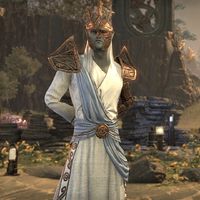
The Tribunal, after taking a brief hiatus from the practice during the Three Banners War,[118] resumed their annual pilgrimages to Red Mountain to renew their divine energies with the Heart of Lorkhan. When they arrived in 2E 882 for their yearly ritual, they were met with an event that would change the course of Morrowind's history.[119]
Voryn Dagoth's essence had somehow not been fully destroyed at the Battle of Red Mountain as initially believed, he and his kin lay dreaming beneath the sills of Red Mountain (a time period known as the Long Sleep.)[119] Voryn Dagoth's body was dead but Dagoth Ur (as his new incarnation would come to be known) had formed a unique connection with the Heart of Lorkhan and become the False Dreamer,[45][49] and despite his death the Sharmat dreamt that he lived[120] and thus he and his seven kin were revived in the year 2E 882.[119] Upon awaking refreshed underneath Red Mountain, Dagoth Ur and his kin moved into the Heart Chamber and Dagoth Ur bound himself and his brothers to the Heart in a ritual of his own devising.[119] This event caused Red Mountain to erupt a second time.[60] Immediately thereafter initial stages of construction began on a project conceived during the Long Sleep for a Second Numidium known as Akulakhan which was tended to by his seven heartwight brothers and atronach constructs.[119]
When Almsivi arrived to Red Mountain and proceeded to the Heart Chamber, they were ambushed by Dagoth Ur and his seven brothers.[119] Given that Dagoth Ur and the Ash Vampires were drawing from the same power source the Tribunal were, they not only outnumbered but greatly outmatched the trio. In fact, the Tribunal barely survived the encounter and were only able to withdraw due to a cunning trick.[121] While Sotha Sil returned to his Clockwork City to make a Second Heart of Lorkhan as he deemed its loss too crucial,[121] Vivec helped lead refugees away from the devastating Ash Blight that Dagoth Ur's return had brought.[60]
Vivec led Dunmer refugees to the city of Gnisis where the citizens and the weary living god could rest.[60] When Vivec awoke, he and all of his followers were frozen solid in castes of ash. Being unable to help his people filled the Warrior-Poet's heart with grief and he began to weep, his tears weakened his ash caste and he was able to break free and thereafter destroy the castes his people were trapped in, he breathed life back into them and revived them and cured them of Dagoth Ur's blight.[60] These tumultuous times during the return of Dagoth Ur and subsequent eruption of Red Mountain were known as the Days of Fire.[60]
The Red Jewel of Conquest[edit]
In the midst of these events an individual by the name of Tiber Septim was annexing Tamriel for his newly founded Empire.[38] Tiber Septim was initially hesitant to seek war upon the Dark Elves, but he had a dream of a united Tamriel, he also coveted the rich source of ebony that could be found in Morrowind in order to fund his rapidly expanding empire.[38] Some sources also suggest that Tiber was persuaded to make war with the Tribunal by their ancient enemy Ysmir Wulfharth, who had adopted the title the Underking.[38] Zurin Arctus advised against this but the strong need for ebony ultimately won out and Tiber set his eyes on Morrowind.[38]
On the fields of battle, several skirmishes took place, contrived border incidents in Black Marsh ended inconclusively as the swampy terrain left the legion navy at a disadvantage.[122] Deeper into mainland Morrowind one severely impactful battle saw the city of one of the living gods, Mournhold laid waste to. A princess by the name of Barenziah was recovered from the rubble of this battle and spared by Tiber Septim at the behest of his Dunmer general Symmachus as he believed the girl could be of some use to the empire some day.[123][124]
Behind the scenes, diplomatic endeavors took place between Tiber Septim and his closest advisors, and the Tribunal spearheaded by Vivec. Tiber Septim and all three of the Tribunal were said to have broken bread together on one particular occasion,[UOL 11] on another Vivec personally traveled to the Imperial City for a meeting with Septim,[UOL 11] Zurin Arctus was believed to have been deeply involved in these negotiations.[122] Some peculiar sources claim that on one occasion Vivec killed Tiber Septim, although the implications of this statement are not clear.[UOL 11]
Reservations began to brew on both sides as the Tribunal did not want to exhaust resources when they had the looming threat of the newly returned Dagoth Ur to deal with and also the issue of not being able to renew their divine energy because of this.[119] On the Empire's side, Tiber Septim was similarly compelled to seek truce as he did not wish to go to full fledge war with Living Gods and Tiber Septim too worried about the wild card that was Dagoth Ur.[80]
This led to the signing of the Armistice, per terms of the deal Morrowind maintained near full religious and cultural autonomy a right no other province possessed, the Empire in turn received Morrowind as an official province of the Empire and to help Tiber Septim conquer the last group that evaded him, the Aldmeri Dominion led by the Altmer of the Summerset Isles, Vivec gifted Tiber Septim the all powerful golem, the Numidium and helped oversee its reorganization.[122][38][UOL 11]
Vivec appeared before his people including the Temple hierarchy and Grand Council to announce the armistice but ensured his people they retained all rights of faith and self governance.[122] While the Temple, Redoran, Hlaalu, and a Telvanni who wished to go the path of least resistance supported the decision of their living gods, Indoril swore they would resist to the death and Dres supported them.[122] This led to the Lord High Councilor of the Grand Council, an Indoril who refused to acknowledge the Armistice and refused to step down to be assassinated and in his place a Hlaalu was installed.[122] Much blood was shed between the houses in various coups in the midst of the transition, more than they shed against the conflict with the Empire itself.[122]
The aftermath on the Empire's side saw Ysmir Wulfharth furious that such unique concessions were made to the Dunmer and their way of faith, validating his bitter rivals the Tribunal.[38] He abandoned the Empire but Tiber Septim realized he needed a power source for the Numidium that was gifted to him, and so tricked Wulfharth into returning under the guise of a campaign to kill the Tribunal.[38] Wulfharth and Zurin Arctus were both killed in this struggle but Tiber Septim succeeded in trapping Wulfharth's essence into the Mantella and with the brass golem he marched onto Summerset and crushed the Altmer into submission.[38] For the first time in Tamriel's history, every province was under one banner, the banner of the Third Empire,[38] Morrowind held the distinction of the only province to not be conquered by Septim's legions.[125]
It is worth noting that Vivec had prophesied the rise of Tiber Septim, and even that of his advisor whom he had a unique connection with known as the "Enantiomorph" Zurin Arctus in his Sermons. He referred to this pairing as the two-headed Ruling King who had no equivalent, and the Red Jewel of Conquest.[52][67] It can therefor be said that Vivec had known it was inevitable that Septim's Empire would come to incorporate Morrowind.
Keeper of the Holy Land[edit]
Vivec, Almalexia, and Sotha Sil continued their seasonal journey to Red Mountain although with the citadel now being guarded by Dagoth Ur and his Ash Vampires, it was no longer a mere yearly pilgrimage but a war campaign.[119] The Tribunal succeeded on numerous occasions in defeating and even slaying Dagoth Ur and the Heart-Wights, but the Heart of Lorkhan always revived them in short order before Almsivi could gain access to the Heart Chamber.[69] Realizing they couldn't destroy these malevolent spirits, and in response to Dagoth Ur spreading his Blight onto the land, and creating legions of powerful ash creatures and deranged corprus beasts, the Tribunal acted fast to maintain this evil, thus the Great Ghostfence was constructed.[69]
The Great Ghostfence was built and sustained by the divine powers of Vivec and the Tribunal,[126] in addition to help maintain the gargantuan structure that circled all of Red Mountain was the remains of deceased Dunmer. The more remains were added the more powerful the fence became and especially so with the remains of mortals who were more powerful in life.[127]
While the Tribunal, particularly Vivec and Almalexia were always protective over the narrative surrounding their divinity and rule,[128] this increased ten fold when the Ghostfence was erected as the fence was largely sustained by the power of the Tribunal and with them no longer able to replenish their powers with the Heart of Lorkhan, they had to rely more than ever on the maximum amount of power received from the faith of the Dunmer populace as possible in order to keep darkness from descending on the land.[69] This led to a persecution of the Dissident Priests, a cult that questioned the origins and reign of Almsivi.[72] There was also heavy push back on the Nerevarine Prophecy that spoke to Nerevar being reborn and coming to set things right in Morrowind.[129][130][131]
With Sotha Sil spending much of his time reshaping the world in his Clockwork City, and Almalexia tending to her city on the Mainland, Vivec found himself largely responsible for protecting the land of Vvardenfell. Because of this, he was recognized as the invisible keeper of the holy land of Vvardenfell, ever vigilant against Dagoth Ur and his Ash Vampires, the dark gods of Red Mountain.[13] The Tribunal continued to reunite for yearly campaigns against Dagoth Ur and his brothers, but the Sixth House continued to gain ground slowly over time. The Blight became worse and Dagoth Ur was able to spread his influence with the Blight, causing more and more to join his forces. The Sixth House reestablished their old fort of Kogoruhn, and eventually there were small cells of Sixth House cultists in every town on Vvardenfell. All the while, Almsivi still had not managed to regain access to the Heart Chamber.[119]
In 3E 317 the Tribunal were dealt a devastating setback when Almalexia and Sotha Sil lost two of the three Tools of Kagrenac Keening and Sunder to Ash Vampires Dagoth Odros and Dagoth Vemyn.[119] Vivec managed to save his fellow Tribunes but they were unable to recover the Tools.[119] The Tribunal parted ways after this defeat with each returning to their cities.[119] They all continued to perform their ritual functions to keep the Ghostfence in tact[119] but beyond that Almalexia had completely secluded into her palace surrounded by Her Hands on the mainland away from the brunt of the Blight spread,[132] Sotha Sil was completely absent in his Clockwork City realm continuing to work on his Second Heart of Lorkhan contingency,[121] thus Vivec alone remained on Vvardenfell with a desire to not lose to Dagoth Ur beyond all other ambitions.[69]
The Nerevarine Prophecy[edit]
In 3E 427 the Blight had become as potent and deadly as ever leading to soul sickness among the Dunmer.[133] Dagoth Ur used his divine will to invade the dreams of Morrowind citizens[119] and used diplomacy to compel Dunmer who were angry with the Tribunal over the Empire's presence in Morrowind to join his side.[134] The Sixth House had grown incredibly powerful and bold, murdering prominent Imperial citizens, Hlaalu Imperial sympathizers,[119] and even Temple Ordinators.[135]
In the midst of this crisis a mysterious outsider was sent to Vvardenfell at the behest of Emperor Uriel Septim VII[136] and with the aid of a Blades Spymaster Caius Cosades began to undergo steps that aligned with the Nerevarine Prophecies.[137][138][139]
Vivec and the Temple labeled the figure an enemy which caused the Ordinators to be hostile to them,[140] this was because much like the conflict with the Dissident Priests, the Nerevarine was viewed as a potential threat to the belief of the Dunmer faithful which Vivec needed to help maintain the Ghostfence.[23][69] This changed when Vvardenfell Great Houses named this outsider the Hortator and the local Ashlander tribes named them the Nerevarine.
The Temple Archcanon Tholer Saryoni proclaimed that despite the previous conflicts the Temple was desperate and that the Nerevarine Prophecies were perhaps their best last hope.[23] This led to a face to face meeting between the Nerevarine and Vivec where Vivec announced he was ending the persecution of the Dissident Priests and end the curse on the Nerevarine announcing the hero as to all of Morrowind as the prophesied savior, champion of the temple and last hope to vanquish Dagoth Ur and his Sixth House.[69] In turn the Nerevarine swore an oath to destroy Dagoth Ur to the best of their abilities.[69] Vivec entrusted the Nerevarine with the last Tool of Kagrenac in the Tribunal's possession, Wraithguard. Vivec took the Nerevarine outside of time in order to teach them how to use Wraithguard and acted as their guide and councilor in the coming campaign against Dagoth Ur imparting wisdom on them before the hero departed for Red Mountain.[69]
The Nerevarine followed the steps laid out by Vivec and was able to sever the enchantments Kagrenac had made on the Heart of Lorkhan freeing the Heart, and destroying the giant Golem Akulakhan that the Sixth House was constructing around it.[141] The Nerevarine then defeated Dagoth Ur in personal combat and without the Heart the sorcerer was no more.[141] Dagoth Ur and the Heartwights were no more, and Vivec, Almalexia, and Sotha Sil were alive but had lost their connection to the Heart completely. Vivec and the Nerevarine had another encounter in which Vivec informed the Nerevarine that the Tribunal had lost the brunt of their divine powers but not all of them as the faith of the Dunmer populace gave them a semblance of remaining power that Vivec intended to use for more humble needs of the people.[69] Vivec predicted that the Tribunal's days as gods were numbered and that they would be merely honored as saints and the Dunmer would eventually return to worshipping the old trio of Daedric gods Azura, Boethiah, and Mephala.[69] Vivec yielded the duties of keeping Morrowind safe to the Nerevarine.[69]
After these events were concluded, the Nerevarine found themselves visiting the mainland into Mournhold the city of Almalexia. Almalexia acknowledged the Hero as the Nerevarine and thus, the reincarnation of her husband Nerevar.[39] After performing various tasks for the goddess Almalexia tasked the Nerevarine with slaying her fellow Tribune, Sotha Sil, as the Lady of Mercy claimed Sotha Sil had become a mad god and was responsible for unfortunate occurrences that had befallen the city.[39] The Nerevarine trekked through the Clockwork City and upon reaching the personal chambers of Sotha Sil, found the Wizard had already been slain.[142] It was in fact Almalexia who had gone mad as a result of the loss of the Heart of Lorkhan and in a desperate attempt to maintain power, killed Sotha Sil with an intention to also kill Vivec so she could become the one and only god of Morrowind and receive all of the power of worship for herself.[142][39] The Nerevarine proved to be too much for the goddess and she was killed by the hero.[142] Azura appeared before the Nerevarine shortly after this and claimed that despite Vivec still being alive, she believed his time grew short.[143]
A final conversation between Nerevar Reborn and the last remaining god of Almsivi saw the Nerevarine informing Vivec about the fate of his fellow Tribunes, which Vivec lamented but accepted as an inevitability.[69] Thereafter Vivec ventured to the Clockwork City to retrieve the bodies of Sotha Sil and Almalexia, and interred the bodies of his fallen Tribunes in the proper Velothi fashion.[UOL 4]
Fate and Legacy[edit]
After the Nerevarine Prophecy was concluded the status of Vivec became murky. Some sources claimed Vivec much like Almalexia, Sotha Sil, and Dagoth Ur, died in the wake of the Nerevarine's wrath,[80] and Vivec admitted as much to the Nerevarine that it was possible they would die by their hand.[69] Other accounts claim that Vivec stood on trial at Hogithum Hall in the Imperial City for his and the Tribunal's usurpation of the three Good Daedra. This account goes on to state that Vivec tricked the council of witnesses presiding over his trial to summon Azura. Vivec then bound her to Tamriel, and stuffed her mouth with Muatra, banishing her in retaliation for the role she played in the Tribunal's demise. Thereafter, Vivec vanished without a trace.[UOL 12][UOL 13] It is said he disappeared to unrecorded planes, now thieving from them for his own amusement.[UOL 4]
Another occurrence that supposedly involved Vivec that suggests he lived beyond his dealings with the Nerevarine is the account of Saint Jiub. Jiub claims that when he collapsed from exhaustion and wounds after eradicating the last of the Cliff Racers he awoke in the presence of Vivec who saw something in him and saved him, which began Jiub's rise to Sainthood.[144]
The last known rumor of Vivec's fate was in 3E 433 at the onset of the Oblivion Crisis, it was said that both the Nerevarine and Vivec had disappeared at this time, with rumors swirling that the Nerevarine had went on an expedition to Akavir and that Vivec had been taken by the Daedric hordes of Mehrunes Dagon.[19] Because of the absence of these two leaders, the Redoran capital city Ald'ruhn was destroyed despite a valiant effort by the city to go as far to revive the giant Emperor Crab Skar to attempt to ward off the invasion but it too fell. Prayers to the Nerevarine and Vivec went unanswered as the Daedric legions continued to march through Vvardenfell. [145][UOL 14]
With Vivec's absence, there were further troubles when the magic that held Baar Dau above Vivec City began to weaken.[146] Two Dunmer by the name of Sul and Vuhon bargained with the Daedric Prince Clavicus Vile to make a device known as the Ingenium which could continue to hold Baar Dau aloft but in exchange the device required souls to power it which were transferred to the realm of Vile.[146] When Sul's lover Ilzheven, was taken to power the Ingenium, in 4E 5 he destroyed it in an attempt to save her. [146]
This caused Baar Dau to crash into Vivec City, resulting in the eruption of Red Mountain and the destruction of Vvardenfell and part of mainland Morrowind.[147] This event became known as the Red Year. Some Dunmer who were spared from the destruction on the mainland claimed it was the Tribunal watching over them but with destruction abound on Vvardenfell and elsewhere on the mainland and the complete absence of the Tribunal who were now believed by many to be either dead or missing, the face of the Dunmer pantheon changed.[147]
As Vivec predicted, Almsivi were relegated to Dunmeri Saints and acknowledged as great heroes, but not anyone who should have ever been the cornerstone of the Dunmer faith.[7][148][149] Also aligning with Vivec's prognostication was the return of the worship of the Three Good Daedra.[7] Where under the worship of Almsivi they were known as the Anticipations, they now held names like the Reclamations[7] and the True Tribunal.[148] This New Temple replaced the old Tribunal Temple as the Dunmer people moved forward with these changes.[148][7]
By 4E 201 the worship of the Tribunal had faded tremendously and was now considered heretical by the majority of the Dunmer populace.[150] However, several vestiges of the Tribunal faith remained in hidden sects and elsewhere. Sotha Sil's Clockwork Apostles were still inhabiting the Clockwork City around this time[151] and despite being aware of his death still worshipped the Tinkerer.[152] Furthermore, one sect of Tribunal worshippers resided on the Morrowind controlled island of Solstheim.[153] These worshippers had Hands of Almalexia, Ordinators and descendants of Buoyant Armigers among their ranks and old Temple priests.[154][155] This group claimed that when the great egg Baar Dau cracked open, it spawned the Dissident Priests and other naysayers which led to the downfall of the Tribunal, but they were able to see past the falsehoods of Lie Rock. [156]
According to one account, this sect of worshippers recruited the aid of the Last Dragonborn to recover the three important artifacts associated with the Tribunal, the War Headdress of Almalexia, the Clockwork Mask of Sotha Sil, and the Ash Mask of Vivec.[157] When the Dragonborn recovered these masks, they then learned of a fourth mask, the Mask of Dagoth Ur that had found its way to the island as well. The mask appeared to still contain some degree of the Sharmat's influence as it had a will to still see the destruction of the Tribunal and any who would serve them.[158] The mask had converted some of the Tribunal faithful into veneration of Dagoth Ur[159] and one of the priests, Erden Relvel served as a puppet for the mask.[158] The Last Dragonborn then defeated Erden Relvel and claimed the mask, putting an end to the threat.[160] However, according to another account, the Last Dragonborn aided the New Temple instead, wiping out the Tribunal worshippers and claiming their treasures.[153]
Divinity[edit]
Worship[edit]
Vivec's spheres were vast as he embodied many traits such as artistry, rogues,[161] lust, murder, sex, secrets, warriors, poets,[2] humility, daring, generosity, courtesy, justice, valor, and pride.[162] Also while Vivec was mastery, given that he was merely an aspect of the greater being known as ALMSIVI, he also occasionally was associated with spheres more normally tied to his fellow Tribunes such as mystery and mercy.[163][164]
The Dunmer faithful came to understand that the Tribunal were anticipated by the three Good Daedra before their existence.[165] Vivec was anticipated by Mephala who much like he was manifold and androgynous.[165] It is stated that through superhuman questing, virtue, discipline, and battling with evil the Tribunal were conferred immortality and divinity from these Good Daedra, and two of their greatest champions Veloth the Pilgrim and Nerevar.[73][72][166]
Upon their ascension the Tribunal ordered the Daedra to give them proper veneration and obedience. It is said the three Anticipations acknowledged the might of Almsivi thus they became known as the Good Daedra, whereas the rebel Princes Molag Bal, Mehrunes Dagon, Sheogorath, and Malacath refuse to abide the Tribunal and thus became known as the House of Troubles.[165][167]
Given Vivec's association with and view by the Dunmer people as the transcendent evolution of the Daedra who anticipated him Mephala, a much darker side of the Warrior-Poet that entailed assassination, sex, and murder was accepted as an integral part of his divine aspect although downplayed in Temple doctrine.[2]
As Mephala was associated with the Dunmer assassin guild the Morag Tong Vivec naturally took this role as the main patron of their order after his ascension calling the shots of the guild in the shadows.[168][169]
Vivec's personal honor guard that he created the Buoyant Armigers as opposed to the more solemn Ordinators, perform deeds to emulate the courageous zeal and flamboyance of the Master of Morrowind.[83] They value the virtues of courtesy, wit, poetry, and riddling.[170] In essence, the Buoyant Armigers venerate and emulate the much more eccentric side of Vivec. The Armigers quested at the behest of Vivec.[171] Vivec blessed one of his favored Armigers with a priceless glass blade known as Enamor.[172][170]
As arguably the most beloved Tribunal, Vivec's praises were sung from the rooftops and every corner club.[85] The Dunmer people held a great festival for the Living God every year on his birthday that he celebrated alongside them.[UOL 15]
Outsiders largely held a much more negative perspective on Vivec and the Tribunal. After Vivec and Nerevar traveled to Yokuda in the First Era and Vivec chose a Yokudan king for a wife,[51] he gained great infamy among the Yokudans and their Redguard descendants. Vivec was known and feared amongst the Redguards as the Circle Talker, or the Ansu-Gurleht in Yoku, the God of Makes Us Women.[UOL 1]
To many Nords Vivec was known as Vehk the Devil,[20] Vivec was famously an adversary of the Nordic king of legend Ysmir Wulfharth who Vivec had many encounters with.[38][37][20] The Nords saw Vivec's attractions to murderous intentions and lustful thoughts to be unnatural and disturbing.[85]
The Imperials often refer to Vivec as Vivek and treat the Tribunal pantheon as a heathen religion, and also find them mysterious.[1] Other Imperial accounts remember him as Vivec the Liar, a false-god of the Dunmer who fancied himself an equal of the Empire.[21]
The Dunmer's cousins the Altmer have been known to describe the Tribunal as a trio of wily demonspawn,[173] although they have been known to acknowledge their power and divinity.[1]
One very dubious theory posits that the Tribunal aren't three separate deities, but rather one giant monster from beyond the Void who sought to harvest souls for some kind of higher power.[174]
Despite these various racial biases in truth other individuals than just Dunmer took part in a benevolent worship of Vivec and the Tribunal such as Imperial and Breton members of the Tribunal Temple[175][176] and even Argonian and Bosmer priests of the Tribunal.[177][178] Also the Clockwork Apostles who pay special homage to Sotha Sil but revere all of Almsivi make up members of nearly every common race.[179] The Buoyant Armigers of Vivec despite being mostly comprised of Dunmer had a Nord who was considered a hero amongst the order.[180][181]
Aspects[edit]
As a divine being, Vivec is said to be capable of taking on several aspects.
Demonic Vehk
Vivec possessed a pre-chimerical form that was gaunt, pale, and beautiful. In this form he possessed a set of red and yellow wings taking on an angelic appearance. His arms were encircled by feathered serpents with skin stretched painfully thin upon bird bones.[182]
God
Vivec possessed a more monstrous looking aspect with horns jutting out of his face and sharp, fang-like teeth. The aspect was depicted on certain Daedric masks that were illegal to wear for anyone other than a Vivecian priest.[UOL 16]
Water Face
Vivec learned the technique of the Water Face from the Dreugh before he was born. When Vivec wore this visage, it rendered him unable to lie as it came from the ocean, which was too busy to think let alone lie.[50] Vivec used this aspect when he felt compelled to give straightforward truth rather than metaphor and riddle.[50][11][UOL 12][UOL 17]
Giant-Form
In this gargantuan aspect, Vivec took on large foes such as Molag Bal[41] and his various monster children created with Bal such as the Ruddy Man,[57] and Moon Axle.[53] During the Pomegranate Banquet, Molag Bal filled Vivec's feet with Daedra blood which allowed him to be able to keep from falling into the divine earth.[46] The aspect was also used for more jovial occasions such as celebrations held in honor of Vivec to make him more of a focal point.[UOL 15]
God-City
When Vivec City began its expansion beyond the remains of Horde Mountain into something greater, Vivec incorporated pieces of his divine essence into gems known as Blessing Stones, which were then built into the core of the expanding city.[114][110] This process expanded the divinity of Vivec, making his essence much more in tune with his city giving him a sort of omnipresence throughout the city.[182] Even when he would leave the borders of Morrowind, Vivec would still make reference to the connection referring to himself as the city that walks.[UOL 1] Some Dunmer incorporated replica Blessing Stones into their personal homes to feel as though the comforting presence of Vivec was always with them.[183]
Teachings[edit]
As a poet, teacher, and councilor, Vivec had various teachings and philosophies on a wide array of topics. Vivec claimed all words were based on meat and that no word was true until eaten.[184] The Sermons of Vivec were beside the bed of every faithful citizen in Morrowind.[185] Even outsiders were known to study the teachings of Vivec to try and gain an insight on ancient magics,[186] with others being mesmerized by the artistry of his works.[187] Some less versed in the Dunmer culture found its esoteric nature too confusing to grasp.[85] Below are some of the topics found in Vivec's various teachings.
Almalexia[edit]
Vivec said Ayem contained the splendor of the stars and would refer to her as the "Star" he also spoke of her as the plot of Almsivi's role in the fate of the Dunmer people. In combat, Vivec described Ayem as the Face-Snaked queen of Almsivi and further compared her beauty to the stars. Vivec described Ayem as a comfortable and secure serenity.[69][188][45][70]
Sotha Sil[edit]
Vivec associated Seht with the selfishness of the sea. He also described Seht as the mechanism that allowed the transformation of the world referring to the supposed reshaping of Nirn that Seht undertook in his Clockwork City. Because of this Vivec likened Seht with the ending of the role Almsivi had in the Dunmer's fate. Vivec described Seht as self absorbed, iconoclastic, unconventional, and profane.[69][188][45]
Ruling King[edit]
Vivec acknowledged both himself and the Enantiomorph that was comprised of the individuals Tiber Septim and Zurin Arctus as Ruling Kings of the world. Vivec described the burdens he would face as Ruling King with insufferable things and the duty to weigh matters of incomprehensible magnitude. Vivec's Sermons spoke of his attempts to teach the Hortator Nerevar how to become a Ruling King, and these lessons also served as a guide for Nerevar's reincarnation to come the Nerevarine. Vivec claimed the Ruling King that saw in another his equivalent ruled nothing, that they were armored head to toe in brilliant flame. Vivec stated that learning the secret syllable of royalty, CHIM was essential to becoming a Ruling King of the world.[188][33][45][49][52]
Vivec's further lessons on how the Nerevar and or his incarnations could become the new Ruling King entailed the removal of Vivec, as his removal would mean the Heart of Lorkhan would be replenished which would spite the Sharmat. The Ruling King would need to stand against Vivec, and then before him, and learn from his punishment. While Vivec claimed to be the Ruling Kings maker, his greatest enemy was the Sharmat, the False Dreamer. Vivec claimed that Nerevar the Ruling King alone, could unmake the Sharmat, and that he should go into his den armed with the power of CHIM.[188][33][45][49][52]
Dagoth Ur[edit]
Vivec referred to Dagoth Ur as the Sharmat, or the False Dreamer. The Sharmat was closely tethered to the Hortator who was his double, Vivec claimed the Sharmat itself was older than music. Vivec noted Dagoth Ur had the passion of madness and he was simultaneously wise and disordered, in short, a mad god.[69][188][45][49]
Lorkhan[edit]
Vivec referred to Lorkhan by several names such as Void Ghost, Frame-Maker, Second Serpent, and Scarab. Vivec claims Lorkhan was the first born of Padomay and in the initial formation of the world of Nirn, Lorkhan attempted to leave creation behind and it was then he encountered the Tower. It was well documented that the subsequent experiments Lorkhan attempted with this metaphysical Tower was the first attempt at the enlightenment state known as CHIM, which Lorkhan failed. It was a subject of debate if the failure of CHIM was intentional or not on Lorkhan's behalf, but Vivec theorized perhaps he failed so mortals would know how not to.[14][75][189][UOL 17]
Anu and Padomay[edit]
Vivec referred to Anu and Padomay with their common names and also, Anu and His Double, Stasis and Change, and ANU and Padhome. Vivec attributed Anu and Padomay with the creation of the Aurbis. From here Anu and Padomay gave birth to their souls, Anuiel and Sithis, and their first born children Akatosh and Lorkhan respectively. Vivec cites mythology of Anu and Padomay to support his interpretation of the concept of love.[190][UOL 17]
Personal Life[edit]
Appearance[edit]
Vivec was tall and powerfully built, and has been described as a handsome individual with an intelligent face.[81] He once had hair in the style of a mohawk similar to his liege Nerevar,[UOL 6] but later on shaved it to "make room for the fire". That is to say, the Poet often adorned a flaming crown of fire atop his bald head.[50] While usually appearing clean shaven, some subjects swear by Vivec's beard.[191] As a mortal he was a Chimer in appearance through and through but after Azura's curse and the creation of the Dunmer he took on a half Chimer half Dunmer appearance with the only thing he occasionally changed being his eyes. At times he kept a matching set of Dunmer red eyes,[192] other times a matching set of Chimer gold,[193] and other times most fittingly, one red and one golden eye.[194] Ancient Chimeri half-masks were thought by some to have been crafted in emulation of Vivec, others held the controversial opinion that Vivec took a liking to a Chimer artisan's work and mirrored it in his appearance as a god.[195] At times Vivec adorned his face with his Daedric sigil namesake Vehk. He was said to smell of a fortune of Telvanni Bug Musk.[UOL 1] Prince Irnskar described Vivec speaking as hearing the chimes of the universe.[196]
Vivec's gender as a mortal was said to be dualistic as he claimed to be born both male and female,[UOL 3] as a god he only emphasized this more along with many other dualistic traits referring to himself as the magic hermaphrodite.[10] Vivec wished to be every race, every gender, both divine and finite all simultaneously as he craved the death of all limits and restrictions.[197]
Family[edit]
And make a secret door
At the altar of Padhome,
In the House of Boet-hi-Ah
Where we become safe
And looked after."
—Vivec's comforting poem to his mother Berahzic and his mightiest child Gulga Mor Jil right before their deaths
Vivec was born to Chimer parents, a mother named Berahzic and a father named Irdri.[UOL 2] As a divine hermaphrodite, Vivec was able to both birth and sire children. He sired a group of monster children with Yokudan kings,[51] and birthed thousands of monster children from his unholy union with Molag Bal.[41] He referred to Almalexia and Sotha Sil as his "sister" and his "brother"[45] which was largely metaphorical and not actually indicative of blood relation, although it did speak to a deeper meaning in that they had a unified connection from their shared relationship with the Heart of Lorkhan.[UOL 18]
Artifacts[edit]
Several artifacts are associated with the Warrior-Poet.
Muatra[edit]
Muatra,[nb 1] meaning Milk Taker, is a spear wielded by Vivec, one of the living gods of the Tribunal.[46] In his younger years, Vivec had a chance encounter with the Hortator of the Chimer Indoril Nerevar, telling Nerevar that he would make a legend of the netch longhook in his possession and that it would be his weapon of choice in Nerevar's guard.[UOL 3] The longhook was in his possession from the days of his youth where he bonded with his father Irdri who was a netchiman by trade.[22][UOL 2]
During the event known as the Pomegranate Banquet in which Vivec and Molag Bal made an unholy union, Vivec noticed his body was tenderly used and pointed this out; Molag Bal replied, stating that his love was accidentally shaped like a spear. Vivec bit new words onto Molag's spear so it could give more than ruin.[46] Disaster was struck when the Chimer, Demons, and Monsters who bore witness to this took out their spears and imitated this biting which caused the earth to crack, spawning a new terrible race that was born of the biters and caused destruction. Vivec, however, had learned a new secret from Molag Bal when he had bitten him, and thus was able to change his own spear into a more terrible thing.[46]
Vivec named his new spear Muatra. The spear in this new form had the ability to turn anyone Vivec touched with it barren and wither them to bones.[46] Vivec used Muatra to destroy many things, including: the biters and their progeny;[46] his own progeny he created with Molag Bal, including eight particularly powerful children who escaped his initial wrath; the last of the N'chorbal, which were terrible rock-skin bugs native to Vvardenfell;[UOL 19] and, according to some legends, even Nerevar himself.[UOL 6] Muatra, along with Vivec's Lyre, is often depicted in shrines and tapestries as the harp and spear are symbols of Vivec.[198][199][200]
Sword Not Held[edit]
The sword not held is an artifact of the Tribunal god Vivec.[53] The sword not held is a curved,[53] bright,[201] silver longsword[60] that, as the name implies, was not grasped when used in combat. When Vivec went to fight one of his monster children, Moon Axle, he learned that the monster was immune to spears. Instead of using his spear, Muatra, he used the sword not held.[53] Vivec also utilized the blade to some degree against his other monster children, City-Face and the Ruddy Man.
A Dunmeri legend speaks of a battle between Vivec and the Daedric Prince Mehrunes Dagon in which Vivec gave the Daedra Lord his sword rather than dishonor himself by fighting an unarmed foe.[60] One particular Dunmeri fable claims Vivec severed a withered hand from a cripple using his sword in order to teach the lesson that it was better to let go of an evil thing than to cling to it for pity's sake.[201] Another legend speaks of a sword meeting between Vivec and Cyrus the Redguard in which Vivec wielded the sword not held.[UOL 1]
Vivec is depicted with the artifact in various shrines and tapestries. Vivec's sigil was that of the sword, he was known as the Sword of the Triune, and his city was referred to as the City of Swords.[202]
Vivec's Ash Mask[edit]
Vivec's Ash Mask, also known simply as the Mask of Vivec, is a holy relic of the Dunmeri god Vivec that was once kept in the temple of Gnisis, where it attracted pilgrims from all over Morrowind for the Pilgrimages of the Seven Graces.[203] The mask was created in the early days of the return of the Sharmat Dagoth Ur. When he rained the blight and ash among the Dunmer people, Vivec helped his people flee and gathered them to the site of modern day Gnisis where they could rest. When they awoke, all of the Dunmeri people and even Lord Vivec himself were encased in casts of ash. Vivec, overwhelmed with grief, shed tears which weakened his ash cast and he was able to free himself and all of his people and then revive them and cure them of the blight.[60] The mask was the center of one of the Shrines of the Seven Graces known specifically as the Shrine of Justice.[60] The sacred Mask was left in Gnisis after Vivec made a potion there to cure a villager who had fallen ill but could not pay for the healing. The Mask served as his promise that the Temple would always cure those who could not pay.[204] Touching it would cure people of their common and blight diseases.[204]
It is one of the Masks of the Tribunal, the other two being Almalexia's War Mask, and the Mask of Sotha Sil.[157]
Vivec's Lyre[edit]
Vivec's Lyre is a musical instrument in the possession of the Tribunal god Vivec. Vivec's use of his Lyre is emphasized as one of the many contributors to his dualistic nature, being a warrior of the Blade and bard of the Lyre.[205][206] Vivec is sometimes given the appellation "the Lyre".[205] The instrument is often depicted alongside Vivec's spear Muatra in various shrines,[207] and tapestries as the harp and spear are considered symbols of Vivec.[199][208] As a musician and a Warrior-Poet, Vivec often writes his own ballads that he then sings in his temple.[209][210]
Fulcrum Obscura[edit]
The Fulcrum Obscura was an artifact associated with several individuals, including Vivec. Prior Durdryn, founder of the Necrom Necropolis and the Keepers of the Dead was an associate and subject of the Tribunal who had a great skill of deducing the secrets of Oblivion from his various dealings with the Daedra.[68]
Vivec gifted the Prior the tusks of his mighty progeny he had slain, Gulga Mor Jil, and tasked Durdryn with using his Daedric connections to imbue the item with great power.[68] The Prior summoned the Daedric Prince Hermaeus Mora for aid.[68][211] Some sort of bargain was struck between the two and Mora gifted the Prior with runes that had the ability to uncover secrets of any kind no matter how elusive.[68][211] Prior Durdryn then inscribed the runes on the tusks of Gulga Mor Jil creating the powerful Fulcrum Obscura.[68][211] Durdryn then presented Vivec with the artifact who did not divulge what intentions he had for the item.[68] Vivec eventually returned the Fulcrum to the Prior who cherished it until his eventual death.[68]
Bibliography[edit]
Works Written[edit]
The 36 Lessons of Vivec[edit]
| Name | Description |
|---|---|
| Sermon Zero of the Thirty-and-Six-and-Nine Sermons of Vivec† | A strange and offensive document about Vivec, purported to be one of his 36 Sermons |
| 36 Lessons of Vivec, Sermon 1 | Book 1 of a series of words of wisdom relating to Vivec |
| 36 Lessons of Vivec, Sermon 2 | Book 2 of a series of words of wisdom relating to Vivec |
| 36 Lessons of Vivec, Sermon 3 | Book 3 of a series of words of wisdom relating to Vivec |
| 36 Lessons of Vivec, Sermon 4 | Book 4 of a series of words of wisdom relating to Vivec |
| 36 Lessons of Vivec, Sermon 5 | Book 5 of a series of words of wisdom relating to Vivec |
| 36 Lessons of Vivec, Sermon 6 | Book 6 of a series of words of wisdom relating to Vivec |
| 36 Lessons of Vivec, Sermon 7 | Book 7 of a series of words of wisdom relating to Vivec |
| 36 Lessons of Vivec, Sermon 8 | Book 8 of a series of words of wisdom relating to Vivec |
| 36 Lessons of Vivec, Sermon 9 | Book 9 of a series of words of wisdom relating to Vivec |
| 36 Lessons of Vivec, Sermon 10 | Book 10 of a series of words of wisdom relating to Vivec |
| 36 Lessons of Vivec, Sermon 11 | Book 11 of a series of words of wisdom relating to Vivec |
| 36 Lessons of Vivec, Sermon 12 | Book 12 of a series of words of wisdom relating to Vivec |
| 36 Lessons of Vivec, Sermon 13 | Book 13 of a series of words of wisdom relating to Vivec |
| 36 Lessons of Vivec, Sermon 14 | Book 14 of a series of words of wisdom relating to Vivec |
| 36 Lessons of Vivec, Sermon 15 | Book 15 of a series of words of wisdom relating to Vivec |
| 36 Lessons of Vivec, Sermon 16 | Book 16 of a series of words of wisdom relating to Vivec |
| 36 Lessons of Vivec, Sermon 17 | Book 17 of a series of words of wisdom relating to Vivec |
| 36 Lessons of Vivec, Sermon 18 | Book 18 of a series of words of wisdom relating to Vivec |
| 36 Lessons of Vivec, Sermon 19 | Book 19 of a series of words of wisdom relating to Vivec |
| 36 Lessons of Vivec, Sermon 20 | Book 20 of a series of words of wisdom relating to Vivec |
| 36 Lessons of Vivec, Sermon 21 | Book 21 of a series of words of wisdom relating to Vivec |
| 36 Lessons of Vivec, Sermon 22 | Book 22 of a series of words of wisdom relating to Vivec |
| 36 Lessons of Vivec, Sermon 23 | Book 23 of a series of words of wisdom relating to Vivec |
| 36 Lessons of Vivec, Sermon 24 | Book 24 of a series of words of wisdom relating to Vivec |
| 36 Lessons of Vivec, Sermon 25 | Book 25 of a series of words of wisdom relating to Vivec |
| 36 Lessons of Vivec, Sermon 26 | Book 26 of a series of words of wisdom relating to Vivec |
| 36 Lessons of Vivec, Sermon 27 | Book 27 of a series of words of wisdom relating to Vivec |
| 36 Lessons of Vivec, Sermon 28 | Book 28 of a series of words of wisdom relating to Vivec |
| 36 Lessons of Vivec, Sermon 29 | Book 29 of a series of words of wisdom relating to Vivec |
| 36 Lessons of Vivec, Sermon 30 | Book 30 of a series of words of wisdom relating to Vivec |
| 36 Lessons of Vivec, Sermon 31 | Book 31 of a series of words of wisdom relating to Vivec |
| 36 Lessons of Vivec, Sermon 32 | Book 32 of a series of words of wisdom relating to Vivec |
| 36 Lessons of Vivec, Sermon 33 | Book 33 of a series of words of wisdom relating to Vivec |
| 36 Lessons of Vivec, Sermon 34 | Book 34 of a series of words of wisdom relating to Vivec |
| 36 Lessons of Vivec, Sermon 35 | Book 35 of a series of words of wisdom relating to Vivec |
| 36 Lessons of Vivec, Sermon 36 | Book 36 of a series of words of wisdom relating to Vivec |
| 36 Lessons of Vivec, Sermon 37 | Book 37 of a series of words of wisdom relating to Vivec |
Other Works Authored[edit]
| Name | Description |
|---|---|
| The Battle of Red Mountain | The story of the Battle of Red Mountain and the Nerevarine Prophecies from Vivec's perspective |
| The Cantatas of Vivec° | A book of gospels in the form of epic songs |
| Crafting Motif 47: Buoyant Armiger Style | A guide to crafting armor and weapons in the Buoyant Armiger style |
| Vehk's Book of Hours† | Vehk's words regarding the Middle Dawn |
| Vehk's Book of the Last Hour† | Vehk's words regarding his trip to Cyrodiil |
| The Plan to Defeat Dagoth Ur± | A detailed plan to defeat the enemy of the Tribunal |
Featured In[edit]
2920, The Last Year of the First Era[edit]
| Name | Author | Description |
|---|---|---|
| 2920, Morning Star | Carlovac Townway | Volume 1 of a historical series about Vivec and the Empire |
| 2920, First Seed | Carlovac Townway | Volume 3 of a historical series about Vivec and the Empire |
| 2920, MidYear | Carlovac Townway | Volume 6 of a historical series about Vivec and the Empire |
| 2920, Sun's Height | Carlovac Townway | Volume 7 of a historical series about Vivec and the Empire |
| 2920, Last Seed | Carlovac Townway | Volume 8 of a historical series about Vivec and the Empire |
| 2920, Hearth Fire≈ | Carlovac Townway | Volume 9 of a historical series about Vivec and the Empire |
| 2920, Frostfall≈ | Carlovac Townway | Volume 10 of a historical series about Vivec and the Empire |
| 2920, Sun's Dusk | Carlovac Townway | Volume 11 of a historical series about Vivec and the Empire |
| 2920, Evening Star | Carlovac Townway | Volume 12 of a historical series about Vivec and the Empire |
Other Works Featuring Vivec[edit]
| Name | Author | Description |
|---|---|---|
| The Anticipations | Anonymous | Overview of the members of and the relationship between the Tribunal and the Daedra |
| Blessed Almalexia's Fables for Morning | A book of fables | |
| Buoyant Armigers: Swords of Vivec | Tarvus, Archcanon of Vivec | A description of the buoyant armigers |
| Dagoth Ur's Plans± | Tribunal Temple | Dagoth Ur's motivations and objectives in his war on Morrowind |
| Fellowship of the Temple | Archcanon Tholer Saryoni | Evangelical and documentative orthodox work of the Tribunal Temple |
| Five Songs of King Wulfharth | A summary of five epic songs of the Ash King, plus an apocryphal song of the Tribunal, Dagoth-Ur and Nerevar | |
| Homilies of Blessed Almalexia | Almalexia | A series of children's fables, each with its own moral |
| Kagrenac's Tools | Gilvas Barelo | Concerning the use of Wraithguard, Keening, and Sunder at Red Mountain |
| Lord Vivec's Sword-Meeting With Cyrus the Restless† | A tale of Cyrus' quest for a Yokudan treasure and his duel with the Ansu-Gurleht | |
| Meet the Character - Vivec | Rigurt the Brash | A Nord diplomat's report about meeting the Warrior-Poet |
| Nerevar at Red Mountain | the Tribunal Temple | A scholarly description of the events surrounding the Battle at Red Mountain and its aftermath |
| The Pilgrim's Path | Tribunal Temple | A book describing each of the Temple's shrines |
| Pocket Guide to the Empire, First Edition | Imperial Geographical Society | |
| Pocket Guide to the Empire, Third Edition | Imperial Geographical Society | |
| The Reclamations | Thara of Rihad | An account of changes in the Dunmer religion following the end of the Tribunal |
| Saryoni's Sermons | Archcanon Tholer Saryoni | Annotated text of the Temple with commentary by Archcanon Tholer Saryoni |
| The Spires of the 34th Sermon | Zamshiq af-Halazh, University of Gwylim | A story of a Dunmer journeying to Vivec to learn the truth behind the thirty-fourth sermon |
| Varieties of Faith: The Dark Elves | Brother Mikhael Karkuxor of the Imperial College | A summary of the Dunmeri pantheon |
| Vivec and Mephala | Informational book about ALMSIVI and Mephala | |
| The War of the First Council | Agrippa Fundilius | A brief account of a First Era religious conflict |
| What My Beloved Taught Me† | A meeting between a street urchin and a caravan guard |
Gallery[edit]
Notes[edit]
- Vivec made a pact with Sheogorath that protected the Dunmer people to some degree from madness.[23]
- Vivec had a confrontation with Mehrunes Dagon on the site of modern day Maar Gan where Dagon threatened to heave a large rock at the Dunmer but Vivec taunted the Prince making himself the target. The rock became enshrined at Maar Gan and was known as the Magic Rock of Maar Gan.[212]
- Vivec was robbed by the infamous Bandit God Baan Dar, who somehow stole the Poet's 37th Sermon before it was even written.[213]
- In Tribunal mythology, it is claimed Vivec was responsible for the creation of Nix-Hounds, that he created the beasts to help hunt down Dreughs during a time lost war campaign against them.[UOL 4] Vivec once conjured a humongous creature that ressembled a Nix-hound to serve as his beast of burden in his giant form.[UOL 15]
- Vivec once paid a visit to Davon's Watch to purchase one of their fine horse steeds.[214]
- A drink, Vivec's Gingergreen Chai was named for the God. Whether he was involved in the recipe's creation, or if it was simply named after him is unknown.
- Michael Kirkbride, the designer and writer of the character, confirmed that Vivec was partly inspired by the Hindu God Shiva's androgynous form, Ardhanarishvara.[UOL 20]
- When the Tribunal's appearance, personalities, placement in the story were first concieved, the character was originally named Vivane, which was unintentionally taken from Earthdawn.[UOL 4][UOL 21] Kirkbride asked Kurt Kuhlmann to rename the character, who chose to change it to Vivek, and sent a couple emails spelling it as "Vivec", which Kirkbride preferred due to its phonetic similarity to the word "insect". Kuhlmann still preferred the spelling of "Vivek" and used it in his section to the PGE1, giving instructions not to change it in the final book, hence why it is the only instance of the spelling in the series.[UOL 4]
See Also[edit]
- For game-specific information, see the Morrowind, Elder Scrolls Online
 , and Legends
, and Legends articles.
articles.
References[edit]
- ^ a b c d e Pocket Guide to the Empire, 1st Edition: Morrowind — Imperial Geographical Society, 2E 864
- ^ a b c d e Vivec and Mephala
- ^ a b c The Living Gods — Durillis the Theologian
- ^ Guide to Vivec
- ^ Guide to Vvardenfell
- ^ Plan to Defeat Dagoth Ur — Vivec
- ^ a b c d e The Reclamations — Thara of Rihad
- ^ a b c d e Vivec, The Warrior-Poet
- ^ a b c The Book of Dawn and Dusk
- ^ a b c d e f g h i j k l 36 Lessons of Vivec, Sermon 18 — Vivec
- ^ a b c d e 36 Lessons of Vivec, Sermon 31 — Vivec
- ^ a b c d On Moving Ebonheart — Archcanon Tarvus
- ^ a b c d e Varieties of Faith... — Brother Mikhael Karkuxor of the Imperial College
- ^ a b c d e f g h 36 Lessons of Vivec, Sermon 33 — Vivec
- ^ Statue of Vivec the Champion from ESO: Morrowind
- ^ a b 36 Lessons of Vivec, Sermon 6 — Vivec
- ^ The Spires of the 34th Sermon — Zamshiq af-Halazh, University of Gwylim
- ^ Malacath's dialogue in Morrowind
- ^ a b Radiant Conversations in Oblivion
- ^ a b c d e f g Five Songs of King Wulfharth
- ^ a b The Siege of Ald Marak — Siege-Master Germia Demetrius
- ^ a b 36 Lessons of Vivec, Sermon 37 — Vivec
- ^ a b c d Tholer Saryoni's dialogue in Morrowind
- ^ a b c A Brief History of Ald Sotha — Varlinsi Arandu, Apostle of Sotha Sil
- ^ a b c d e f g h The Battle of Red Mountain — Vivec
- ^ a b c d e f Nerevar at Red Mountain — the Tribunal Temple
- ^ a b Ordinator Nelyn's dialogue in ESO
- ^ a b c d e 36 Lessons of Vivec, Sermon 1 — Vivec
- ^ Lord Fa-Nuit-Hen and Tutor Riparius Answer Your Questions 2 — Fa-Nuit-Hen and Tutor Riparius
- ^ Fa-Nuit-Hen's dialogue in ESO: Orsinium
- ^ 36 Lessons of Vivec, Sermon 2 — Vivec
- ^ a b 36 Lessons of Vivec, Sermon 3 — Vivec
- ^ a b c 36 Lessons of Vivec, Sermon 4 — Vivec
- ^ a b 36 Lessons of Vivec, Sermon 5 — Vivec
- ^ 36 Lessons of Vivec, Sermon 7 — Vivec
- ^ 36 Lessons of Vivec, Sermon 8 — Vivec
- ^ a b c d e f g 36 Lessons of Vivec, Sermon 9 — Vivec
- ^ a b c d e f g h i j k l m The Arcturian Heresy — The Underking, Ysmir Kingmaker
- ^ a b c d e f g h Almalexia's dialogue in Morrowind: Tribunal
- ^ Generic dialogue regarding Vivec in Morrowind
- ^ a b c d e f g h i j k l m n o 36 Lessons of Vivec, Sermon 12 — Vivec
- ^ The House of Troubles
- ^ Tusenend loading screen in ESO: Morrowind
- ^ a b Varieties of Faith: The Dark Elves — Brother Mikhael Karkuxor of the Imperial College
- ^ a b c d e f g h i j 36 Lessons of Vivec, Sermon 13 — Vivec
- ^ a b c d e f g h i j k l 36 Lessons of Vivec, Sermon 14 — Vivec
- ^ a b Tholer Saryoni's dialogue during Molag Bal of the House of Troubles in Morrowind
- ^ Monk Methas Irethi's dialogue in ESO
- ^ a b c d e 36 Lessons of Vivec, Sermon 15 — Vivec
- ^ a b c d e 36 Lessons of Vivec, Sermon 16 — Vivec
- ^ a b c d e f g h i j 36 Lessons of Vivec, Sermon 17 — Vivec
- ^ a b c d e 36 Lessons of Vivec, Sermon 19 — Vivec
- ^ a b c d e f g 36 Lessons of Vivec, Sermon 20 — Vivec
- ^ a b c d 36 Lessons of Vivec, Sermon 22 — Vivec
- ^ a b c 36 Lessons of Vivec, Sermon 24 — Vivec
- ^ a b 36 Lessons of Vivec, Sermon 26 — Vivec
- ^ a b c 36 Lessons of Vivec, Sermon 28 — Vivec
- ^ Creating ESO: The Dreugh
- ^ Ruddy Man Rhyme
- ^ a b c d e f g h i j k The Pilgrim's Path — Tribunal Temple
- ^ Ibaal's dialogue during An Armiger's Duty in ESO: Morrowind
- ^ Captain Naros' dialogue during An Armiger's Duty in ESO: Morrowind
- ^ a b c 36 Lessons of Vivec, Sermon 30 — Vivec
- ^ a b Crafting Motif 47: Buoyant Armiger Style — Lord Vivec
- ^ A Tale of Baar Dau — Amili Drals, Pedagogue
- ^ a b c Testimonials on Baar Dau — Minerva Calo, Associate Chronicler
- ^ a b c d e f g h i 36 Lessons of Vivec, Sermon 34 — Vivec
- ^ a b c d e f g h The Prior's Fulcrum — Abbot Ilvel
- ^ a b c d e f g h i j k l m n o p q r s t Vivec's dialogue in Morrowind
- ^ a b c d 36 Lessons of Vivec, Sermon 36 — Vivec
- ^ 36 Lessons of Vivec, Sermon 29 — Vivec
- ^ a b c Progress of Truth — Dissident Priests
- ^ a b Fellowship of the Temple — Archcanon Tholer Saryoni
- ^ Description of the Sword of the Saint during Trials and Tribulations in ESO
- ^ a b 36 Lessons of Vivec, Sermon 10 — Vivec
- ^ 36 Lessons of Vivec, Sermon 32 — Vivec
- ^ Divayth Fyr's dialogue in ESO: Clockwork City
- ^ Almalexia's appearance in Morrowind: Tribunal
- ^ Poison Song — Bristin Xel
- ^ a b c d e f g Pocket Guide to the Empire, 3rd Edition: The Temple: Morrowind — Imperial Geographical Society, 3E 432
- ^ a b c d e f 2920, The Last Year of the First Era — Carlovac Townway
- ^ Inveigling the Clockwork Apostles — A Helpful Citizen
- ^ a b Buoyant Armigers: Swords of Vivec — Tarvus, Archcanon of Vivec
- ^ Chronometer of the Tribunal from ESO
- ^ a b c d e Understanding the Living Gods — Rigurt the Brash, Nord Cultural Exchange
- ^ a b c Vivec's dialogue in ESO
- ^ Nevrasa Dralor's dialogue in Morrowind
- ^ a b Where Were You ... Dragon Broke — Various
- ^ a b c d Countess Narina Carvain's dialogue in Oblivion
- ^ a b c Reman II: The Limits of Ambition — High King Emeric
- ^ Almalexia dialogue topic in Morrowind
- ^ Pocket Guide to the Empire, 1st Edition: Prologue — Imperial Geographical Society, 2E 864
- ^ Mysterious Akavir
- ^ Jorunn the Skald-King — Helgreir Lute-Voice, Bard of Windhelm
- ^ The Improved Emperor's Guide to Tamriel: Skyrim — Flaccus Terentius, 2E 581
- ^ a b c d The Second Akaviri Invasion — Yngmaer Raven-Quill, Historian Royal of the Bards' College, Solitude
- ^ The Stormfist Clan — Thora Far-Wanderer
- ^ From Argonian to Saxhleel — Vicecanon Heita-Meen (2E 582)
- ^ a b Unexpected Allies — Commentary on the Ebonheart Pact by a Nord soldier
- ^ Priestess Brela's dialogue in ESO
- ^ Ladrasa Bethalas' dialogue in ESO
- ^ Tribunal Walking Stick contraband text in ESO
- ^ a b The Time of the Ebonheart Pact — Alla Llaleth
- ^ Guide to the Ebonheart Pact
- ^ Breaking the Cycle of Tyranny — Alla Llaleth
- ^ Almalexia's dialogue during A Favor Returned in ESO
- ^ Invitation to Morrowind — Canon Llevule
- ^ Lord Vivec's Questions — Vivec
- ^ Farena Andrano's dialogue in ESO
- ^ a b Events of Divine Conundrum in ESO
- ^ Events of Divine Inquiries in ESO
- ^ Events of Divine Delusions in ESO
- ^ Events of Divine Intervention in ESO
- ^ a b Events of Divine Disaster in ESO
- ^ Events of Divine Restoration in ESO
- ^ Events of Divine Blessings in ESO
- ^ Meet the Character - Archcanon Tarvus — Adjuvant Drumara
- ^ Disciple Sildras' dialogue in ESO
- ^ a b c d e f g h i j k l m n o Dagoth Ur's Plans — Tribunal Temple
- ^ Nibani Maesa's dialogue in Morrowind
- ^ a b c Events that occur in the mission The Red Mountain in Return to Clockwork City
- ^ a b c d e f g On Morrowind — Erramanwe of Sunhold
- ^ The Real Barenziah — Anonymous
- ^ Biography of Queen Barenziah — Stern Gamboge, Imperial Scribe
- ^ Artisa Arelas' dialogue in Morrowind
- ^ Generic Dialogue G in Morrowind
- ^ Ancestors and the Dunmer
- ^ Ordinator Edict: Mandate Sixteen — Inquisitor Nivos Uveran
- ^ "Nerevarine cult" generic dialogue in Morrowind
- ^ Nerevarine cult notes — Sharn gra-Muzgob
- ^ Nerevar Moon-and-Star
- ^ Mehra Helas' dialogue in Morrowind: Tribunal
- ^ Yakum Hairshashishi on the topic of Soul sickness in Morrowind
- ^ Orvas Dren's dialogue in Morrowind
- ^ Mysterious Killings in Vivec quest in Morrowind
- ^ Decoded package — Glabrio Bellienus, Personal Secretary to the Emperor
- ^ Report to Caius Cosades quest in Morrowind
- ^ Sixth House Base quest in Morrowind
- ^ Corprus Cure quest in Morrowind
- ^ Events of The Path of the Incarnate in Morrowind
- ^ a b Events of The Citadels of the Sixth House in Morrowind
- ^ a b c The Mad God quest in Morrowind: Tribunal
- ^ Azura's dialogue in Morrowind
- ^ Saint Jiub's Opus — Jiub
- ^ History of Raven Rock, Vol. I — Lyrin Telleno
- ^ a b c The Infernal City — Greg Keyes
- ^ a b The Red Year — Melis Ravel
- ^ a b c Elder Othreloth's dialogue in Skyrim: Dragonborn
- ^ Galdrus Hlervu's dialogue in Skyrim: Dragonborn
- ^ Heretic Dossier: Blacksmith's Confessional
- ^ Clockwork Apostles appearance in Return to Clockwork City
- ^ Brass Fortress Market Square in Return to Clockwork City
- ^ a b Ghosts of the Tribunal quest in Skyrim
- ^ Hand Indobar's Journal — Hand Kydren Indobar
- ^ Vesparth's Journal
- ^ Propaganda Letter
- ^ a b Masks of the Tribunal
- ^ a b Erden Relvel's Note — Erden Relvel
- ^ Priest Arthamis' Note — Arthamis
- ^ Ashen Heart quest in the Ghosts of the Tribunal Creation for Skyrim
- ^ Generic dialogue about greater saints in Morrowind
- ^ Saryoni's Sermons — Archcanon Tholer Saryoni
- ^ The Consolations of Prayer
- ^ Vivec's Mercy in Morrowind
- ^ a b c The Anticipations — Anonymous
- ^ The Cantatas of Vivec
- ^ Darkest Darkness
- ^ Fire and Darkness — Ynir Gorming
- ^ Naryu's Journal/Vvardenfell, Before — Naryu Virian
- ^ a b Salyn Sarethi's dialogue in Morrowind
- ^ Necrom Armiger Face Markings in ESO
- ^ Enamor quest in Morrowind
- ^ Regarding the Ebonheart Pact — Aicantar of Shimmerene, Sapiarch of Indoctrination
- ^ Tribunal—Living Lies — "Disordinator"
- ^ Viatrix Petilia's dialogue in Morrowind
- ^ Melie Frenck's dialogue in Morrowind
- ^ Counts-the-Clouds' dialogue in ESO
- ^ High-Pockets' dialogue in Tribunal
- ^ Clockwork Apostles in ESO
- ^ Uvoo Llaren's dialogue in Morrowind
- ^ Mendel Eves in Morrowind
- ^ a b 36 Lessons of Vivec, Sermon 25 — Vivec
- ^ Replica Blessing Stone contraband text in ESO
- ^ 36 Lessons of Vivec, Sermon 27 — Vivec
- ^ Servant of Vivec's dialogue in ESO
- ^ Azandar al-Cybiades' dialogue in ESO: Necrom
- ^ Alchemy's dialogue in ESO
- ^ a b c d e 36 Lessons of Vivec, Sermon 11 — Vivec
- ^ 36 Lessons of Vivec, Sermon 21 — Vivec
- ^ 36 Lessons of Vivec, Sermon 35 — Vivec
- ^ Dala Marys' dialogue in ESO
- ^ Vivec's appearance in ESO
- ^ Vivec's appearance in Morrowind
- ^ Vivec's appearance in Legends
- ^ Chimer Half-Mask adornment in ESO
- ^ Prince Irnskar's dialogue in ESO: High Isle
- ^ Sotha Sil's dialogue in ESO: Clockwork City
- ^ Shrine of Warrior-Poet in ESO
- ^ a b Brass Cufflinks of Vivec contraband item in ESO
- ^ Tapestry, Vivec, Banner, Vivec, Indoril Banner, Vivec, and Indoril Carpet, Vivec furnishing items in ESO
- ^ a b Blessed Almalexia's Fables for Morning
- ^ 36 Lessons of Vivec, Sermon 23 — Vivec
- ^ Generic dialogue in Morrowind
- ^ a b Pilgrimages of the Seven Graces quest in Morrowind
- ^ a b Vivec, The Warrior-Poet
- ^ Meet the Character - Vivec — Rigurt the Brash
- ^ Shrine of Warrior-Poet in ESO
- ^ Tapestry, Vivec, Banner, Vivec, Indoril Banner, Vivec, and Indoril Carpet, Vivec furnishing items in ESO
- ^ Vivec's dialogue in ESO
- ^ Overseer Shiralas' dialogue in ESO
- ^ a b c On the Fulcrum Obscura
- ^ Pilgrimage to Maar Gan quest in Morrowind
- ^ The Library of Dusk: Rare Books
- ^ Lorela's dialogue in ESO
Note: The following references are considered to be unofficial sources. They are included to round off this article and may not be authoritative or conclusive.
- ^ a b c d e Lord Vivec's Sword-Meeting With Cyrus the Restless
- ^ a b c Sermon Zero of the Thirty-and-Six-and-Nine Sermons of Vivec — Douglas Goodall
- ^ a b c What My Beloved Taught Me
- ^ a b c d e f Michael Kirkbride's Posts
- ^ Michael Kirkbride's Posts
- ^ a b c Foul Murder
- ^ Pocket Guide to the Empire, Second Edition — the Imperial Geographical Society, 3E 331
- ^ Fireside Chat - Reman and the Shonni-etta
- ^ Interview With Three Writers — Waughin Jarth, Baloth-Kul and Carlovac Townway
- ^ Lawrence Schick's Posts
- ^ a b c d Partial Interview With Vivec — Vivec
- ^ a b Michael Kirkbride's posts in The Trial of Vivec
- ^ Imperial Census of Daedra Lords — the Imperial Geographic Survey
- ^ The Fall of Ald'ruhn
- ^ a b c Vivec's Birthday — Michael Kirkbride
- ^ Morrowind Daedric Helms Concept Art
- ^ a b c The Thief Goes to Cyrodiil — Vivec
- ^ Lore of the Clockwork City on ESO Live
- ^ Douglas Goodall's Posts
- ^ Michael Kirkbride AMA
- ^ Concept Map of Morrowind – The Elder Scrolls III: Morrowind
| ||||||||||||||
| |||||||||||||||||||||||
| ||||||||||||||
